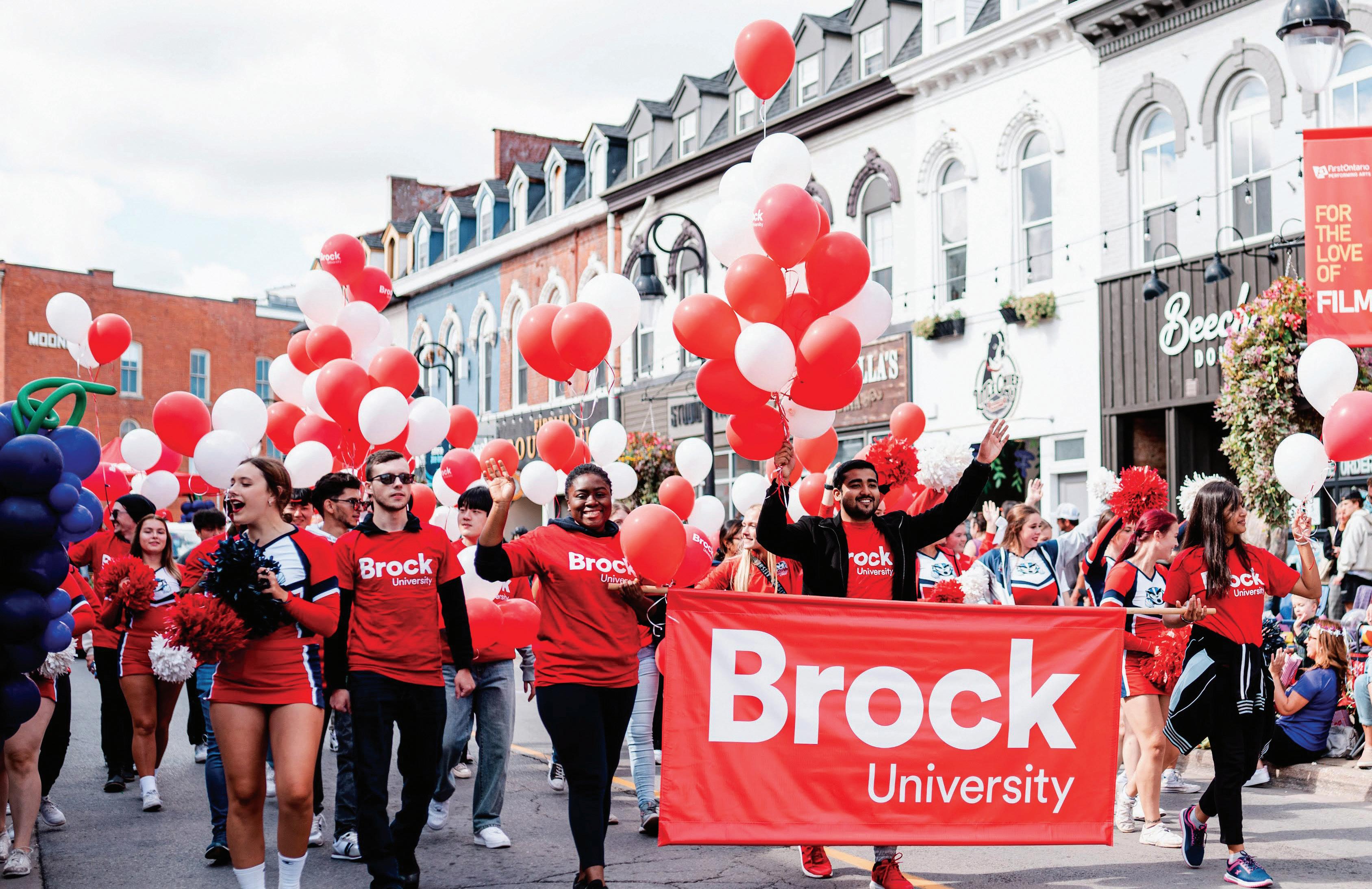

2025-26 Budget Report
Including key performance metrics

Land acknowledgement
Brock University acknowledges the land on which we gather is the traditional territory of the Haudenosaunee and Anishinaabe peoples, many of whom continue to live and work here today. This territory is covered by the Upper Canada Treaties and is within the land protected by the Dish with One Spoon Wampum Agreement. Today, this gathering place is home to many First Nations, Métis and Inuit peoples and acknowledging reminds us that our great standard of living is directly related to the resources and friendship of Indigenous people. brocku.ca/indigenous

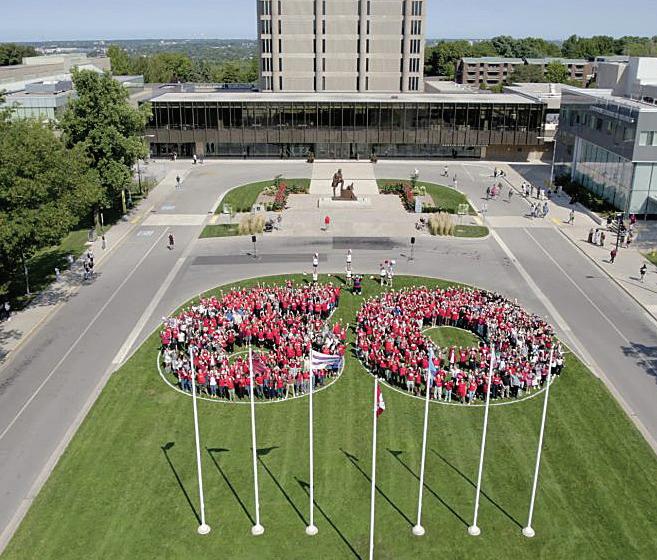
Financial results
The funding budget for fiscal 2025-26 is illustrated in Figure 1. It identifies an in-year mitigation target of $13.6 million, as compared to a mitigation target of $10.1 million in 2024-25. The information below describes our financial health and compares several of our financial health metrics to other comprehensive universities. In addition to the metrics below, Brock's current Morningstar DBRS credit rating is "A (high)" with stable trend. See page 79 for further details of the credit rating.
Operating costs
Personnel costs (270,370) (264,326) (252,467)
Inter-fund expense (19,574) (18,932) (28,418)
Other operating costs (103,566) (108,188) (108,700)
Total operating costs (393,510) (391,446) (389,585)
Funding deficit before mitigation (13,636) (10,088)
Mitigation plan 13,636 10,088
Funding balance after mitigation plan - - -
Statement of operations metrics
The following metrics were developed to identify areas of strength as well as improvement.
(1) Calculated using financial information from 13 comprehensive universities. Certain 2023 metrics have been updated due to revisions in certain universities’ financial statements.
Brock’s tuition is slightly below the average; however, grant revenue per student continues to be well below the sector average and represents an area of ongoing attention for the University. Naturally, Brock operates more efficiently, given the below-average funding, and this results in lower personnel costs per student to counterbalance the lower funding. Brock continues to invest in students through scholarships, bursaries and fellowships. Interest and investment income metrics are in line with Brock’s financial health metrics as detailed below.
Financial health metrics
(1) Calculated using financial information from 13 comprehensive universities. Certain 2023 metrics have been updated due to revisions in certain universities’ financial statements.
(2) The $20-million repayment of the Roy and Lois Cairns Health and Bioscience Research Complex load during 2022-23 causes the one-time swing in this metric.
Refer to page 80 for explanations of the debt-related financial health metrics.
Figure 2
Figure 3
Historical timeline
In planning for the future, it can be useful to look back and ask “How did we get here?” Figures 27 and 28 provided here attempt to rewind the clock and identify some key decisions with significant financial impacts. Figure 27 details the historical audited financial results while Figure 28 details historical undergraduate and graduate student headcounts, and a faculty, professional librarian and staff headcount. An interesting observation is that the student to faculty and librarians ratio, and the staff to faculty and librarians ratio have not changed substantially since 2011-12.
27: 2011 to 2024 historical audited financial results ($ millions)
Note: The figures were obtained from the audited financial statements of Brock University, which were prepared in accordance with Canadian Accounting Standards for Not-For-Profit Organizations (2011-12 to 2023-24).
(1) Faculty and professional librarians headcount figures represent all employees who have an academic appointment in the academic year (July 1 to June 30). Staff headcount figures represent all active ongoing staff (with the exception of BUFA), including fixed-term contracts with benefits, as of October of each year.
(2) Figures represent the number of students in each Faculty of major on Nov. 1 of each academic year (as per PFIS-USER submissions). In addition, starting in 2014-15 figures also include new-entry enrolments as of Feb. 1 for certain International Student Programs (ISPs) and Technological Education and excludes Continuing Teacher Education enrolment.
Figure
Figure 28: 2011 to 2025 Faculty, Staff and Student headcount
Introducing the data points
As part of the budget report, we provide data points to assist users of this report to draw relationships between financial and non-financial data. The goal is to continue the process of providing meaningful data points to help establish a foundation to explain the “why” behind the revenue and expense values and the outcomes the budget supports. The data points presented in this report were chosen in consultation with Institutional Planning, Analysis and Performance (IPAP), with an emphasis on points which have a financial impact. The data points were made available from IPAP as well as other units throughout the University. Your suggestions for future budget reports and key data points are always welcome at budgetreport@brocku.ca
We hope that you find these data points useful and that they encourage constructive and collegial discussion.

Brock was ranked #5 of 15 among Canadian comprehensive universities for library acquisitions. Brock was ranked #5 of 15 among Canadian comprehensive universities for scholarships and bursaries.



Faculty of Applied Health Sciences (FAHS) Goodman School of Business (GSB) Faculty of Education (FOE) Faculty of Humanities (FOH) Faculty of Mathematics and Science (FMS) Faculty of Social Sciences (FOSS) Other



Figures represent the number of students in each Faculty of Major on Nov. 1 of each Academic Year (as per PFIS-USER submissions). In addition, figures also include new-entry enrolments as of Feb. 1 for certain programs. Starting in the 2024-25 Budget Report these headcount figures no longer include Continuing Teacher Education enrolment. The prior year figures have been adjusted for comparability. FTEs are reported based on a student’s


Figure 9: 2024-25 international student headcount by Faculty
Figure
Figure 6: Personnel costs





Figure
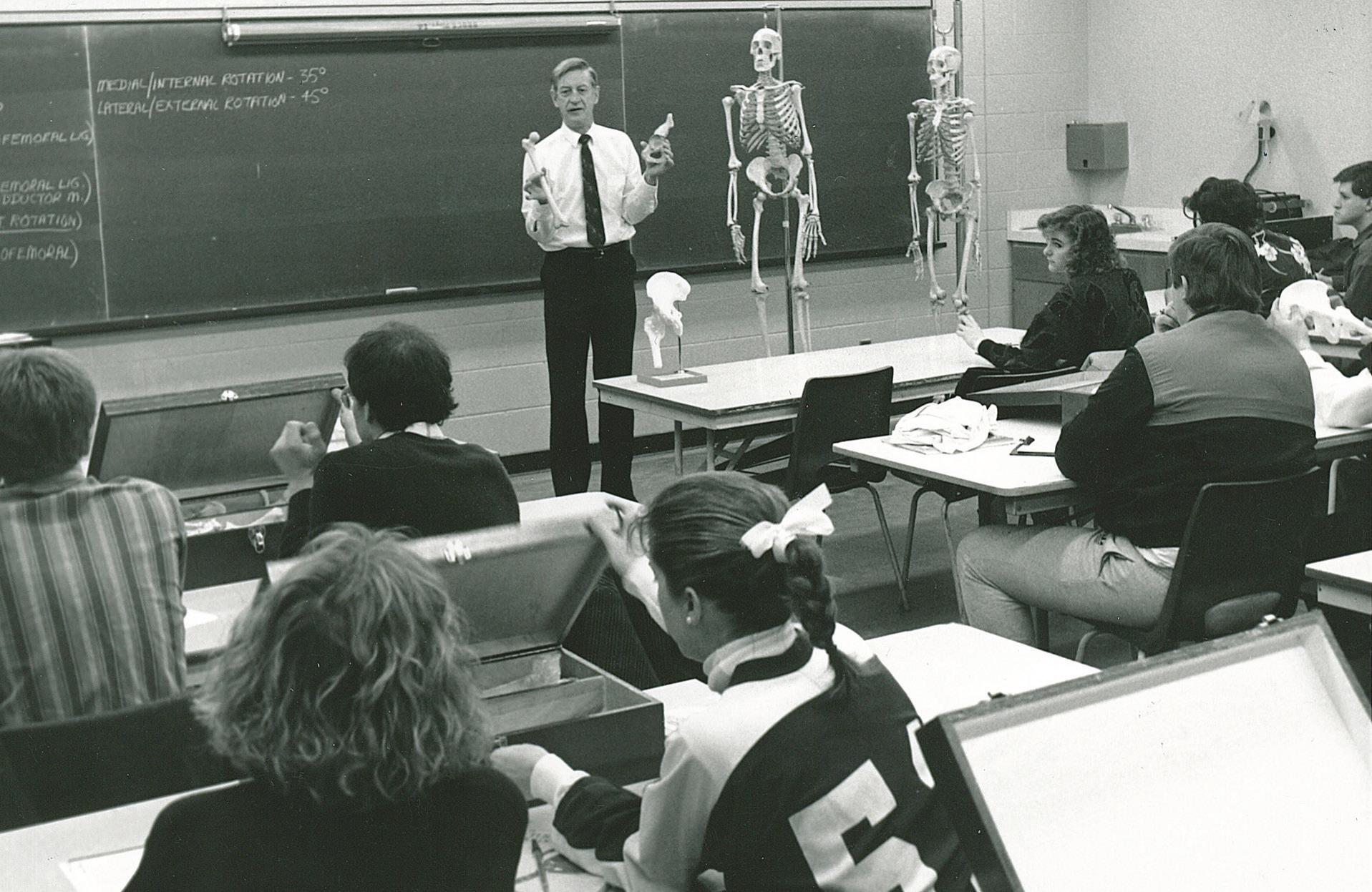

Budget environment
The current budget environment is informed by our Fiscal Framework, enrolment and government policies at both the federal and provincial levels. As a not-for-profit organization, each year our goal is to achieve a balanced budget. Recognizing costs are subject to inflation, our ability to offset these costs with additional revenue is not possible within the confines of current government policy; thus, each year we endeavour to find additional efficiencies and grow revenues to achieve a balanced budget. Demands on the University impose costs that will always exceed its available resources. Brock University must therefore have some means both of setting priorities among its many possible opportunities and of planning to enable the strategies it undertakes. As we have done in past years, consultation with the University community has informed budget development. Integrating the feedback received on the budget within our fiscal parameters and guided by the Strategic Plan, this budget plan provides support for the academic policy of the University while recognizing the constraints that a $13.6 million revenue shortfall will have on mitigation efforts. This discussion on the budget environment serves to highlight areas that significantly impact the budget development.
Enrolment
Enrolment generates the majority of our revenue; thus, it is a key assumption in our budget planning. As noted in the Fiscal Framework, Brock relies on strategic enrolment growth to fund a significant portion of our cost increases given that domestic tuition rates and government grants are regulated
and are not increasing at a rate at all close to the rate of inflation. Enrolment trends have not been favourable for Brock over recent years, which has accelerated our deficit growth. Figure 29 highlights total enrolment since 2016-17 and Figure 30 shows budgeted total revenue against total expense over the same time period. As enrolment peaked in 2019-20 and has since begun to decline, Brock has experienced a flattening of revenue growth and in fact declining overall revenue over the last three budget years. While we have done a lot of work to manage the growth in expenses, universities are not fiscally nimble enough to adapt our cost structures to address significant changes in overall funding, which Brock is experiencing as a result of our enrolment trends.
Figure 30: Total Revenue and Expense Budget ($000s) (1) ‘All-in’ enrolment includes letter of permissions, non-degree students, auditors, and certificates.
Figure 29: All in student headcount related to credit courses (1)
International enrolment continues to be a substantial area of risk for the entire sector as the Federal Government continues to impose caps on international enrolment. What this means for Brock is that undergraduate international intake is expected to decline by 21 per cent which represents a decline of 39 students over prior year budget. Overall international undergraduate enrolment is down 30 per cent which accounts for a 442 student decrease and a $12.4 million decline in tuition revenue over the prior year’s budget.
The next few years will require thoughtful academic led enhancements to curriculum delivery and allocations of limited resources and as we endeavour to regain enrolment growth to meet our fiscal needs.
Government Policy
Brock continues to appreciate its strong and collaborative relationship with the Province of Ontario through the Ministry of Colleges, Universities, Research Excellence and Security (MCURES). Despite the Province’s fiscal constraint, it continues to fund important programs at Brock.
Twelve universities underwent third-party Efficiency and Accountability Fund (EAF) reviews by external consultants in 2024-25, funded by the MCURES. In 2025-26, an additional four to five universities are expected to participate in the EAF reviews. These reviews are part of a Financial Accountability Framework launched in 2024 by MCURES. The university sector’s deteriorating fiscal outlook follows the tuition rate freeze in 2019 after the 10 per cent tuition rate reduction, coupled with limited growth in ongoing base operating grants. These policies created a fiscal environment for the university sector where sustainability relied on incremental enrolment revenue to offset expense inflation. Now, with declining enrolment and government restrictions on international enrolment, universities are faced with an unsustainable operating model. While the EAF reviews looked at many aspects of university operations, the findings will not eliminate Brock’s structural deficit.
At the time of writing in early April 2025, the Provincial Government has not released their 2025-26 budget; however, key commitments were included in their election platform relevant to our sector:
• $5 billion in additional capital for the Building Ontario Fund (BOF), bringing the total amount in the BOF to $8 billion.
• $1 billion more to expand the Skills Development Fund.
• $705 million to expand training capacity at colleges and universities, including:
- $450 million to support Science, Technology, Engineering and Math (STEM) programs, expanding the number of funded seats by over 20,000 annually.
- $75 million to support construction skilled trades programs and create 2,600 new funded seats in priority construction and infrastructure related programs.
• Launch a new publicly available labour market survey to provide a detailed assessment of Ontario’s labour market needs by sector and region.
• Create new scholarship opportunities for First Nations students interested in resource development careers.
• Expand medical school seats across the province – a nearly 50 per cent expansion to residency spots by 2028 and a nearly 40 per cent increase in undergraduate medical spots.
• $88 million in additional funding for the Learn and Stay Grant.
• Removing red tape for medical professionals who want to work in Ontario with new “As of Right” rules.
Brock is anticipating modest upside to grant revenue explained in more detail in the grant revenue section of this report. More work is required with our government partners to address ongoing fiscal sustainability challenges. This work is currently underway through negotiations on the next Strategic Mandate Agreement 4 (SMA4) with the Province. This agreement focuses on accountabilities for funding, including corridor funding under the Enrolment Envelope, performance-based funding under the Differentiation Envelope and STEM allocations. Special purpose/other institutional grants are not included as part of this agreement. SMA4 will run through the fiscal period from April 1, 2025 to March 31, 2030 and has been designed to advance three strategic objectives:
1. Improve education and economic outcomes of students,
2. Improve outcomes for communities, and
3. Support sector stability and accountability.
Performance metrics were established in SMA3 and revisions have been submitted to the Province for approval as part of SMA4. New performance metric approval is anticipated by summer of 2025. The performance metrics that were used for SMA3 are highlighted in Figure 31. There are some changes to these performance metrics including a required reduction from 10 metrics to eight. Again, more information will be shared on SMA4 in future reports once the negotiations are finalized.
Skills and outcomes metrics:
• Graduate employment earnings
• Experiential learning
• Skills and competencies
• Graduate employment
• Graduation rate
• Institutional strength/focus (negotiated metric)
Economic and community impact metrics:
• Research funding and capacity (Tri-Council funding)
• Research funding from private sector sources (innovation)
• Impact in the local community
• Economic impact: Co-op, Nursing and Teacher Education practicum student placements in Niagara (institution-specific)
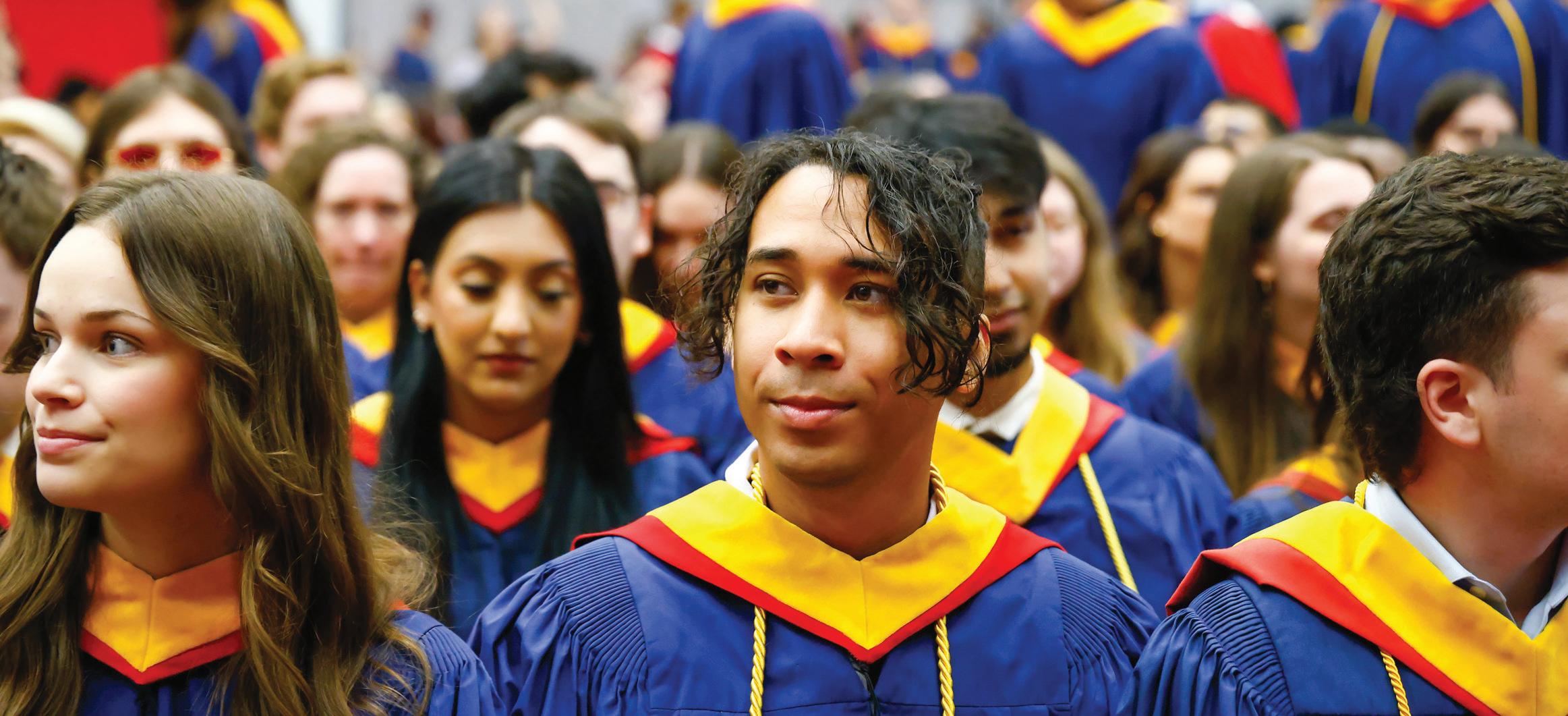
Figure 31: SMA3 Performance-based funding metrics
Fiscal Framework
The provincial government regulates more than half of the University’s revenue and that revenue is predominately subject to zero per cent inflation. With expenses growing at approximately 3.3 per cent annually – and with 69 per cent of expenses associated with personnel costs, most of which is tied to collective agreements – the University is faced with a budget model that must rely on increasing enrolment revenue to fund base operating expense inflation. This framework is highlighted in Figure 32.
As the budget development process began for 2025-26 in the fall of 2024, there was a realization that our funding shortfall would surpass any shortfall experienced in Brock’s history. A $39 million funding shortfall, approximately 10 per cent of the total funding budget, materialized out of the culmination of the many fiscal pressures. The size of this shortfall signaled that we would not be able to meet our Fiscal Framework commitments in the short-term and that a resetting of priorities would need to take place to maintain Brock’s solvency. The word solvency may seem like an extreme concept, but the reality is
every university in Ontario is facing deficits and our ability to fund deficits is limited to our strategic and contingency reserves, which at the time of writing is projected to hold $24.8 million in funding at 2024-25 fiscal year-end. Structural changes are necessary for longer-term sustainability; however, those changes must be informed by strategic academic led reviews which require adequate time for planning and successful implementation. Through a rigorous budget development process, Brock identified $25 million in mitigation to bring the proposed budget deficit to $13.6 million. Recognizing this deficit is larger than historical mitigation targets, this budget plan assumes a mitigation target coupled with potential use of the contingency reserve to fund the balance of our operating costs. Any future surplus will subsequently be earmarked for repayment into our contingency reserve prior to being allocated to other strategic reserves. This strategy could leave Brock with limited reserves at the end of fiscal 2025-26; however, no external financing will be utilized for operating expenses and this will award the institution time to adapt our curriculum delivery for future sustainability.
(1) Although the Province has given Brock grant increases for the next three years, they have not been included in this chart as the increases are not permanent.
Figure 32: Budget Framework
New and ongoing investments
While in-year mitigation targets are established in the budget, these efforts do not overshadow the long-term growth and development of the University. Certain areas will require investment for the University to achieve our strategic goals. The following sections provide additional information in some areas of new and ongoing investment as established in the 2025-26 operating budget.
Indigenous support
• Continued support for the Vice-Provost, Indigenous Engagement.
• Continued support for the Hadiya'dagénhahs
First Nations, Métis and Inuit Student Centre and Undergraduate Aboriginal Studies.
• Targeting scholarship support for Indigenous students, both undergraduate and graduate.
• Faculties supporting growth in Indigenous content in curricula.
• Faculties continue to diversify their faculty complement by appointing Indigenous faculty members.

Teaching Faculties
• Total operating and personnel cost budget: $181.5 million, which is 46.1 per cent of the total University operating and personnel costs budget.
• FTE (2): 824.2
• The Faculty of Applied Health Sciences provides high quality undergraduate and graduate programs, along with extensive practicum and experiential learning opportunities. As a research-intensive Faculty, these experiences are combined with a broad and rich research capacity dedicated to improving health outcomes through health education and policies, physical activity, sports and recreation in collaboration with numerous community partners.
• With an emphasis on its values of professionalism, passion, perseverance and perspective, the Goodman School of Business provides business education that is relevant, equitable and impactful for our students and the community.
• Faculty of Education is strengthening community networks for experiential and work-integrated learning opportunities while enhancing program and student supports which will maintain the Faculty's reputation of graduating highly regarded educators and researchers.
• The Faculty of Humanities is creating exciting new programming in the field of artificial intelligence (AI) with a proposed new interdisciplinary BA. At the same time, the Faculty has a new niche as the home of post-secondary education and training for the fine and performing arts in Ontario, as well as continuing to offer unique experiential education and international opportunities.
• The Faculty of Social Sciences continues to prioritize delivering and developing high quality programs and providing funding for strategic initiatives that serve faculty, staff and students.
• The Faculty of Mathematics and Science launched a BEng Integrated Engineering program in Fall 2024, the first engineering program at Brock University, while establishing new research ties with industry through the Brock-Niagara Validation, Prototyping and Manufacturing Institute (VPMI) and new community ties through numerous events that engage the public in science.
brocku.ca/academics
Research support
• The 2022-23 Fiscal Framework established targeted guidance to build research capacity across the University by ensuring the operating budget for the central research enterprise and Faculty-based research services grow each year by at least the rate of inflation with additional structural adjustments. The inflation adjustment was paused when developing the budgets for 2025-26 and 2024-25 due to the financial situation of the University.
• Total net direct operating budget (1) of the central Research Enterprise and the Office of the Vice-President, Research (VPR): $4.8 million, which is flat as compared to the 2024-25 budget.
• Highlights of some investments in the 2025-26 budget include:
- Grant funding for various items including VPR Research Excellence for Research Initiative Awards, application support, equipment support, Indigenous research, and matching funds as well as Chancellor's Chair and Match of Minds grants.
- Funding for post-doctoral fellowship awards and distinguished/early career research awards.
- Funding the Cool Climate Oenology and Viticulture Institute (CCOVI).
- Funding of the Brock-Niagara Validation, Prototyping and Manufacturing Institute.
brocku.ca/research-at-brock

Library acquisitions
• The Fiscal Framework establishes a goal of benchmarking our acquisitions on a per-student basis against our peers in the Canadian Association of Research Libraries (CARL).
• Net direct operating budget (1) : $6.1 million, which is $0.3 million more than 2024-25 budget.
• Where this is budgeted: As part of the total Library budget of $13.0 million ($12.3 million in 2024-25).
brocku.ca/library

Professional and Continuing Studies (PCS) and English as a Subsequent Language (ESL)
• Professional and Continuing Studies is charged with developing a wide range of continuing education and professional programs with flexible learning opportunities to meet the needs and advance the careers of a wide audience of learners, including current students, graduates, working professionals and retirees. PCS includes many of Brock's non-credit offerings, including Continuing Teacher Education.
• Through PCS, Brock’s ESL Services offers a variety of English as a Second Language courses to help students reach their academic goals of studying in Canada or personal and professional goals of improving their English language skills.
• Operating and personnel budget is $3.1 million, offset by revenue of $3.5 million for a net surplus of $0.4 million.
• FTE (2): 15.8
brocku.ca/continuing-education

Engineering
• The Yousef Haj-Ahmad Department of Engineering is an innovative approach to engineering education tailor-made to address emerging needs and challenges in the field. Brock's unique, made-in-Niagara interdisciplinary program blurs the lines between traditional engineering disciplines, helping the engineers of tomorrow lead in fields as diverse as big data, artificial intelligence, bioengineering, medical devices, sustainability and climate change, robot automation, manufacturing and transportation. The first cohort of students entered the program in 2024-25.
• Operating and personnel cost budget: $2.4 million. This investment is being fully funded by strategic reserves in 2025-26.
• FTE (2): 11.3
• Where this is budgeted: Faculty of Mathematics and Science.
brocku.ca/mathematics-science/engineering



Funding budget
The funding budget is used to communicate the revenue targets and expense authority that support the teaching, research, scholarly, creative and service activities of the University. It fundamentally tracks where cash has been allocated. Figure 33 details the funding budget for 2025-26 in comparison to the 2024-25 budget and 2023-24 actuals. Some reclassifications were made to the 2024-25 budget for comparison purposes when the overall funding budget was not impacted. See Appendix B for a reconciliation of these reclassifications.
Tuition revenue
Tuition revenue, defined as a fee charged for educational instruction, is budgeted to be $168.2 million, $9.5 million lower than the 2024-25 budget. Figures 36 and 37 on the following pages details 2025-26 tuition related to credit and non-credit courses as compared to the 2024-25 budget and 2023-24 actuals.
Tuition revenue related to credit courses
Revenue assumptions Student fees
Student fees include tuition related to credit and non-credit courses as well as fee revenue and represents 47 per cent of total revenue (49 per cent in 2024-25). Student fees are budgeted to be $178.4 million for 2025-26, detailed in Figure 34, which represents a $9.3-million decrease as compared to the 2024-25 budget.

Of the total tuition revenue, $164.4 million relates to credit courses, which is budgeted in the University Global responsibility centre. Figure 36 details the tuition for credit courses by Faculty of major, split by graduate/ undergraduate and domestic/international. Total domestic tuition is budgeted to be $119.2 million, which is $7.6 million more than the 2024-25 budget. Total international tuition is budgeted to be $45.2 million, which is $15.8 million less than the 2024-25 budget. The budget includes $2.6 million for additional tuition related to an effort to increase enrolment during the Spring/ Summer term with the objective of further integrating the term as part of the regular academic schedule at the University. This additional Spring/Summer tuition is included as part of the undergraduate domestic tuition.
Note: Although Figure 36 details tuition by Faculty of major, the revenue and expense allocation model explained in the "Revenue and expense allocation model" section of this report has been adopted and records tuition based on where students take their courses (i.e. teaching Faculty).
2024-25 Budget $174.6 million
• ($6.2) million – 2024-25 Budget to 2024-25 Actual (note: actual tuition was not yet finalized at the time of writing)
• ($8.8) million – Enrolment impact (($11.4) million international, and $2.6 million in additional domestic spring/summer)
• $4.8 million – Rate impact (approved international rates, out of province rates and tuition anomalies) 2025-26 Budget $164.4 million

Figure 34: Student fees
Figure 33
Figure 35:
Figure 36: Tuition revenue related to credit courses (1)
(1) Represents tuition related to Ministry reported enrolment. The figures are based on Faculty of Major.
(2) Includes letter of permission, non-degree students and auditors.
Figure 35 on the previous page includes a reconciliation of the overall change in tuition related to credit courses budgeted for 2025-26 compared to the 2024-25 budget with three main factors. The first is the difference of the 2024-25 budgeted tuition to the 2024-25 actual tuition (estimated at trimester two). This variance of $6.2 million is fully described in the 2024-25 Trimester 2 Report available at brocku.ca/about/university-financials. The second factor is the $8.8 million reduction due to enrolment change as compared to 2024-25 forecasted actuals. The centrally managed enrolment projection model is described in the "Enrolment forecasting" section of this report starting on page 22. As detailed in Figure 37, these projections resulted in an all-in for credit enrolment forecasted decrease of 2.4 per cent over 2024-25 forecasted actual enrolment.
The final factor impacting for credit tuition is the tuition rate change impact of $4.8 million as compared to 2024-25. For an explanation of the tuition fee policies for both government-funded programs and nongovernment-funded programs as well as the approved tuition fee increases for 2025-26 see Appendix D. Tuition rates for domestic students are regulated by the Ministry of Colleges, Universities, Research Excellence and Security (MCURES). On Feb. 27, 2024, Brock received a memo from the MCURES titled “Supporting a Sustainable Postsecondary Education System,” announcing an extension of the general domestic tuition freeze for at least the next three years. Further, the memo provided institutions the flexibility to increase tuition for domestic out-of-province students up to five per cent per year, and communicated that institutions approved for tuition increases as part of the 2023-24 tuition anomalies process may continue to increase tuition up to a maximum of 7.5 per cent per year for first-year incoming students and continuing students that started in 2023-24 and onward. Brock implemented both allowed rate increases, as detailed in Appendix D. Overall, the domestic rate increases contribute $2.9 million of the total tuition rate impact.
International students and other programs that do not receive government grant funding are not regulated by the MCURES. For undergraduate international tuition, a cohort model is used which sees an eight per cent increase each year for Year 1 students only. Tuition rates are then frozen for four additional years to provide students with a total of five years of fixed tuition rates to assist with budget planning and fiscal stability for their four-year degree program, with one additional year to graduate. After the fifth year, the tuition rate
Figure 37: All-in student headcount by type (1)
(1) 'All-in' includes degree seeking, letter of permissions, non-degree, auditors and certificate students.
reverts to the incoming Year 1 tuition rate. The cohort model represents a response to the insights of Brock University units directly working with international students and recognizing that these students would experience significant benefits from having a direct line of sight for tuition rates for all years of study for their program.
International graduate professional programs, including International Student Programs (ISP) tuition rates will be increased by five per cent over 2024-25. Conversely, the international research-based master's and PhD programs tuition rates will not see a change over the 2024-25 rates. Overall, the net impact of international tuition rates changes is a tuition increase of $1.9 million.
Tuition revenue related to non-credit courses
The budgeted tuition related to non-credit programs is $3.8 million as shown in Figure 38. Tuition related to English as a subsequent language (ESL) programs is budgeted to be $1.6 million, which is an increase of $0.1 million as compared with the 2024-25 budget. Professional and Continuing Studies programming tuition revenue is budgeted to be $0.3 million for 2025-26, which is a decrease of $0.6 million compared to the 2024-25 budget. Continuing Teacher Education is budgeted to be $1.1 million which represents an increase of $0.3 million as compared to the 2024-25 budget. Continuing Teacher Education is now supported through Professional and Continuing Studies along with all non-credit programming. As a result, starting in the Fall of 2024-25 Continuing Teacher Education is reported in the Professional and Continuing Studies responsibility centre (PCS). Prior to Fall 2024 it was reported as part of the Faculty of Education. The 2024-25 budget has been adjusted to reflect this change. Also included in non-credit tuition revenue in 2025-26 is tuition related to the Goodman
21 Group, which is reported as part of Goodman School of Business (70 per cent of revenue) and PCS (30 per cent of revenue). Prior to the 2025-26 budget, the revenue of the Goodman Group was shown as part of Sales and Services within the Goodman School of Business. For comparison purposes, the amount for Goodman Group for the 2024-25 Budget and 202324 Actual are detailed in Figure 38. Lastly, starting in the 2025-26 budget, 30 per cent of the Cool Climate Oenology and Viticulture Institute (CCOVI) non-credit tuition revenue of $0.06 million is reported in PCS. This revenue was reported in an internally-restricted reserve in prior years and therefore was not shown in the operating results.
(1) Represents tuition related to enrolment not included in Ministry reporting.
(2) Starting in the fall of 2024, Continuing Teacher Education is reported as part of Professional and Continuing Studies. Prior to fall 2024 it was reported as part of the Faculty of Education.
(3) Starting in the 2025-26 budget, Goodman Group fees are reported as tuition. Prior to the 2025-26 budget this revenue was reported as Sales and Service revenue. For comparison, the Goodman Group 2024-25 budgeted revenue and 2023-24 actuals are shown in the chart.
(4) Starting in the 2025-26 budget a portion of the Cool Climate Oenology and Viticulture Institute (CCOVI) tuition revenue is reported in the operating budget. Prior to 2025-26 this revenue was in an internally restricted reserve.
Figure 38: Tuition relatedto non-credit course(1)
Enrolment forecasting
Enrolment projections – undergraduate
There are two key assumptions in projecting undergraduate enrolment: intake targets for Year 1 and the retention behaviour of current students. For intake purposes, students are classified on the basis of their admission status. Based on observation, each group behaves differently in terms of their retention status: (1) domestic students directly from secondary school, (2) domestic students not directly from secondary school and (3) international students. Figure 39 displays the undergraduate Year 1 (full-time) intake headcount projections for 2025-26 as compared to prior years. Figure 40: Domestic applications directly from secondary school
(1) Intake in Education is related to the new Bachelor of Arts in Educational Studies that started in 2024.
Source: Data was extracted from the PowerBI application details as of March 17, 2025. Figures may differ from prior year as Power BI is a fluid data source.
While overall application volumes are essentially flat compared to last year, Brock continues to see strength in key domestic markets – particularly among direct-from-secondary applicants in Ontario. This steady performance reflects the continued impact of Brock’s early and strategic outreach, particularly in the Greater Toronto Area and Niagara region. As we navigate the final stages of the recruitment cycle with these applicants, the Student Recruitment department continues to support them as they navigate concerns and uncertainty around affordability, program availability and future academic pathways.
Source: Actual values accessed from PowerBI Admissions on March 6, 2025. Values may differ from the 2024-25 Budget Report as PowerBI is a fluid data source. Intake targets are sourced from AVP Enrolment Services and Admissions Office
Intake targets are set through collaboration and consultation with units across the University, including the Faculties. For the purposes of the 2025-26 budget, Year 1 intake is projected to see an increase of 0.6 per cent over 2024-25 actuals, as shown in Figure 39. Year 1 intake is dependent on applications received. Brock's undergraduate applications directly from secondary school are down one per cent over 2024, as shown in Figure 40. Though not uniformly, this decrease is mainly being seen in the Faculties of Humanities and Mathematics and Science with offsetting increases seen in the Faculties of Education, Applied Health Science and the Goodman School of Business.
This domestic momentum stands in contrast to ongoing uncertainty in international student recruitment, where evolving federal regulations – such as the continuation of Provincial Attestation Letters and new study permit caps – have created added complexity for students and institutions alike. Broader challenges to the Canadian education brand, global geopolitical tensions and the ripple effects of international trade disputes have further impacted student mobility and decision-making. Additionally, the potential for future policy changes tied to provincial and federal elections in Ontario and Canada has added a further layer of unpredictability.
In this highly competitive and volatile cycle, Brock has prioritized a strategic, service-oriented approach to recruitment and conversion. Recognizing the need to stand out early, Brock has continued to expedite offers of admission to be among the first institutions to respond – driving early engagement and giving students more time to consider their options. Admissions decisions
Figure 39: Year 1 intake headcount (undergraduate)
are being made quickly and generously, with a focus on helping students access their preferred programs, including flexible consideration for a range of academic backgrounds. This approach is supported by a robust communication plan, which includes email, physical mailing, social media, targeted SMS outreach and more than 10,000 personalized outbound phone calls to applicants.
Conversion activity remains strong, with sustained applicant interest and engagement across all channels. Brock remains focused on deploying new and enhanced strategies to attract and support students. It is hoped the coming year brings greater stability across the sector.
The Year 1 intake figures are then combined with retention and progression rates, as well as movement to and from full-time and part-time status (retention behaviour), to determine a total returning undergraduate headcount. This retention behaviour is determined by reviewing historical enrolment patterns. As an example, Figure 41 shows the return or retention rates of students who entered the University directly from secondary school in 2023 into the 2024-25 year. Note: Retention rates by Faculty are detailed in Figure 19 on the The Big Picture pullout.
After these considerations, for the purposes of the 2025-26 budget, total undergraduate all-in headcount is forecasted to decrease by 415 students or 2.4 per cent as compared to 2024-25 actual headcount, as shown in Figure 42. The decrease in enrolment is seen in all Faculties, the largest being the Faculty of Humanities, the Faculty of Mathematics and Science and the Goodman School of Business. Overall, the decrease is mainly seen
in undergraduate international enrolment which is forecasting a decrease of 25.4 per cent as compared to 2024-25 actuals. There is also a small decease in domestic undergraduate enrolment of 0.4 per cent as compared to 2024-25 actuals, as shown in Figure 37.
Figure 41: 2023-24 cohort activity
2023-24 degree-seeking, first- time, first- year entry cohort
in 2023 as Year 1
in 2024-25
full time as Year 1
full time as Year 2
part time as Year 1
part time as Year 2
Source: November 1 PFIS-USER submissions for both 2023 and 2024, and the 2024 academic year Consortium for Student Retention Data Exchange (CSRDE) submission.
Enrolment projections – graduate
Graduate enrolment projections are produced with intake targets from the Faculty of Graduate Studies and Postdoctoral Affairs (FGPSA) and then combined with historic progression, retention and graduation rates of continuing graduate students. For the purpose of the 2025-26 budget, overall graduate enrolment is forecast to experience a decrease of 48 students or 2.7 per cent compared to actual 2024-25 headcount enrolment. As shown in Figure 42, the Faculties of Applied
(1) 'All-in' includes degree seeking, letter of permissions, non-degree, auditors and certificate students.
Figure 42: All in student headcount related to credit courses – by Faculty (1)
Health Science, Humanities and Social Science are forecasting respective growth in graduate enrolment of 23, 7 and 4 additional students as compared to 2024-25. Decreased graduate enrolment is forecasted in Goodman School of Business by 29 students, the Faculty of Mathematics and Science by 23 and the Faculty of Education with 18 less students as compared to 2024-25. Overall graduate international enrolment is forecasting a decrease of 9.1 per cent as compared with 2024-25, which is offset by graduate domestic enrolment being relatively flat to budget with a 0.3 per cent increase. As of March 21, 2025, the number of graduate applications are flat to this date last year, the number of admitted offers are up 16 per cent and confirmations more than 47 per cent higher.
For both undergraduate and graduate enrolment, once the total forecasted headcount is determined, it is then translated into full-time equivalents (FTEs) based on historical fulltime/part-time student enrolment patterns, which are then combined with the tuition rates to calculate tuition.
Fee revenue
Fee revenue is budgeted to be $10.2 million, which is $0.2 million higher than the 2024-25 budget. Fee revenue includes both ancillary fees and other student fees.
Ancillary fees are established by student referendum, according to the ancillary fee protocol, and agreed to with the Brock University Students’ Union (BUSU) and Graduate Students’ Association (GSA). Some fees can increase automatically (i.e. either each year or after the Consumer Price Index has accumulated to five per cent since the last fee increase). Ancillary fees are all assessed and collected by the University, and are either administered by the University, BUSU or the GSA. Note: Only the University-administered ancillary fees are included as part of the funding budget. The setting of ancillary and administrative fees was delegated to the President and Vice-President, Administration at the Dec. 1, 2016, Board of Trustees meeting.
University-administered ancillary fees are budgeted to be $6.1 million ($6.0 million in 2024-25). Figure 43 details the ancillary student fees, and where these fees are reported can be found in the snapshots section of this budget report.
Figure 43: Ancillary student fees
Other student fees of $4.2 million ($4.1 million in 2024-25) are included as part of fee revenue in the 2025-26 budget. Other student fees include the International Student Recovery Fee, which is offset by a reduction in the MCURES operating grants (International Student Recovery), calculated as $750 per international student. This fee is charged to international students and results in $1.1 million ($1.6 million in 2024-25) of revenue in 2025-26. It is reported as part of the University Global responsibility centre.
Also included in other student fees are program specific fees charged by the program in which a student is enrolled. Included in this figure are $2.1 million ($1.7 million in 2024-25) of co-op fees (reported in Co-op, Career and Experiential Education), $0.2 million ($0.2 million in 2024-25) of ESL ancillary fees for international students (reported in ESL), $0.2 million ($0.2 million in 2024-25) related to the Business English and Skill Transition fee for International Student Program participants in the Goodman School of Business and $0.6 million ($0.4 million in 2024-25) in program related student fees (reported in the Faculties of Applied Health Science and Humanities).
Grant revenue
Grant revenue, as reported in the 2025-26 budget, includes MCURES operating grants and other operating and specific purpose grants. Grant revenue represents 31 per cent of total revenue (28 per cent in 2024-25 budget) and is budgeted to be $119.0 million for 2025-26, which is detailed in Figure 44. Grant revenue is budgeted to increase $13.4 million compared to the 2024-25 budget and $9.0 million compared to actual 2023-24.
The 2025-26 budget for the COG, in combination with the Differentiation Envelope, represents $87.7 million, which is consistent with the 2024-25 budget.
Differentiation Envelope
In 2019, the MCURES announced that performance/ outcomes-based funding would be implemented starting in 2020-21 as part of the Strategic Mandate Agreements 2020-25 (SMA3) process. The use of performance/outcome-based funding will continue in the next Strategic Mandate Agreement 2025-2030 (SMA4) which is currently in the process of being negotiated with the MCURES. This funding model includes tying a larger portion of funding to metric performance, through the Differentiation Envelope, as described in the "Budget Environment" section starting on page 12 of this report. Each university’s Differentiation Envelope proportion varies. The metrics tied to the Differentiation Envelope did not impact the grant funding until 2023-24. For 2025-26, Brock’s Differentiation Envelope is budgeted to be $53.2 million, which represents 52 per cent of the total MCURES operating grants. This amount represents the base amount expected to be received in 2024-25 and does not include any adjustment related to the performance metrics tied to this grant. This grant is reported in the University Global responsibility centre.
Ministry of Colleges, Universities, Research Excellence and Security operating grants
As detailed in Figure 44, MCURES operating grants include the Core Operating Grant (COG), the Differentiation Envelope, the Postsecondary Education Sustainability Fund (PSESF) and the Special Purpose Operating Grant Envelope, offset by the International Student Recovery, all of which are MCURES funded.
Core Operating Grant
The COG represents the portion of the MCURES operating grants that are related to enrolment. The COG funding continues to be governed by an enrolment corridor mechanism, with Brock's midpoint weighted grant units (WGUs) multiplied by the global WGU rate to determine the COG. As of SMA3, the corridor midpoint includes actual enrolment levels in 2019-20, meaning additional growth does not receive additional incremental funding. The midpoint for SMA4 is currently being determined. Brock is budgeting the COG to be $34.5 million in 2025-26, which is reported in the University Global responsibility centre.
Postsecondary Education Sustainability Fund
In February 2024, the Province announced an investment over three years in the PSESF starting in 2024-25 with across-the-board funding of $2.6 million, $4.4 million in 2025-26 and $6.3 million in 2026-27. In June 2024, after the 2024-25 budget was established, the MCURES communicated additional one-time top-up funding for Brock of $6.1 million for 2024-25. In March 2025 the reduced one-time top-up funding for 2025-26 of $3.0 million was communicated. In total the 2025-26 budget for the Postsecondary Education Sustainability Fund is $7.5 million. This funding is reported in the University Global responsibility centre.
Figure 44: Operating grants
Special Purpose Operating Grant Envelope
There is also another major component of the MCURES operating grants, the Special Purpose Operating Grant Envelope, which represents funding by which the government can address system priorities, such as initiatives to support Indigenous learners and students with disabilities. For the purposes of the 2025-26 budget, this envelope includes several MCURES funded grants, as detailed in Figure 45.
• Grant in Lieu of Municipal Taxation: The MCURES provides subsidies to universities to pay their municipal taxes. The municipal tax (payment in lieu of property taxes) is based on a charge of $75 per domestic FTE; however, the related grant does not change with enrolment. The 2025-26 tax payments are budgeted to be $1.3 million ($1.3 million in 2024-25) and the grant is budgeted to be $1.1 million ($1.1 million in 2024-25); therefore, $0.2 million is budgeted to be unfunded through this grant. Both the grant revenue related to the Grant in Lieu of Municipal Taxation and the offsetting payment in lieu of property taxes are reported as part of the Utilities, Taxes and Insurance responsibility centre.
• Grants for Students with Disabilities: The MCURES provides funding to support a wide range of services for students with disabilities through the Access Fund for Students with Disabilities (AFSD) and the Disabilities Interpreters fund. These services include access to adaptive computer and software learning technology; arranging notetaking for students who are visually impaired; and interpreter services for students who are deaf, deafened and hard of hearing. Brock’s funding for 2025-26 is budgeted to be $0.9 million ($0.9 million in 2024-25). The grant revenue related to these grants is shown as part of Student Wellness and Accessibility.
• STEM Sustainability grant: The MCURES considers STEM programs to be critical to Ontario’s prosperity and economic competitiveness. The MCURES will be providing funding to all institutions that provide STEM programming in the province to support them in retaining existing STEM enrolments. The budget for 2025-26 related to this grant is $4.4 million and is shown as part of University Global. This grant was last received in 2023-24 in the amount of $2.6 million.
• Initial Teacher Education grant: The MCURES supports the Teacher Education program through base funding for 736 full-time equivalent (FTEs) in the Core and Differentiation operating grants. However, the 2025-26 FTE budget for funding-eligible teacher education students is 1,103, leaving 367 FTEs without funding. This budget of $1.2 million is related to funding for an additional 192 FTEs, based on what was received in 2024-25. It is important to note that this funding has not been confirmed by the MCURES for 2025-26 at the time of developing the budget. Even with this additional funding, 175 FTEs would still be unfunded in 2025-26. The budget is shown as part of University Global.
• The Indigenous Student Success Fund: The MCURES supports Indigenous students through funding for student support initiatives, academic enrichment and partnership initiatives. The 2025-26 budget for this funding is $0.3 million ($0.3 million in 2024-25), which is reported in Hadiya'dagénhahs First Nations, Métis and Inuit Student Centre.
• Credit Transfer Grant: The MCURES funds support for post-secondary education transfer mobility initiatives. The 2025-26 budget for this funding is $0.2 million ($0.2 million in 2024-25), which is reported in The Office of the Registrar.
• Ontario Post-Secondary Access and Inclusion Program: The MCURES provides funding to support students who might not otherwise access postsecondary education. The 2025-26 budget for this funding is $0.3 million ($0.3 million in 2024-25), which is reported in Student Life and Success.
• Campus Safety Grant: The MCURES provides funding to support sexual violence prevention and campus safety efforts at publicly assisted postsecondary institutions. The 2025-26 budget for this funding is $0.1 million ($0.1 million in 2024-25), which is reported in Human Rights and Equity Services.
Figure 45: Special Purpose Operating Grant Envelope
• Mental Health Grants: The MCURES funds the Mental Health Support for Post-Secondary Education Students Grant and the Mental Health Workers Grant. These grants support mental health initiatives for students. The 2025-26 budget for this funding is $0.1 million ($0.1 million in 2024-25) and $0.1 million ($0.1 million in 2024-25), respectively. Both are reported in Student Wellness and Accessibility.
• Also included in the Special Purpose Operating Grant Envelope is the First Generation Bursary funding and the Ontario Remembrance Scholarship Grant. The grant revenue and their offsetting scholarship and bursary expenses are shown as part of the Scholarship, Bursaries and Fellowships responsibility centre.
International Student Recovery (ISR)
The ISR offsets MCURES operating grants by $750 for every undergraduate- and master’s-level international student. This reduction is budgeted to be $1.1 million in 2025-26 ($1.6 million in 2024-25) and is reported in the University Global responsibility centre. The decrease is aligned with lower international enrolment.
Other MCURES and specific-purpose grants
The University receives a number of other MCURES grants, not included as part of the "MCURES operating grants," as well as a number of other specific-purpose grants, from other levels of government and other granting agencies, detailed in Figure 46.
Figure 46: Other MCURES and specific purpose grants
Nursing students and therefore are budgeting that these will remain unfunded in 2025-26. This grant is reported in the University Global responsibility centre.
Research Support Fund
The Research Support Fund is a Government of Canada funding program to assist Canadian post-secondary institutions in offsetting the cost of administering research awards from the three federal granting councils (Natural Sciences and Engineering Research Council, Social Sciences and Humanities Research Council and the Canadian Institute of Health Research). Brock receives funding to support the indirect costs incurred on Tri-Council-funded research through the program. These costs can include maintenance and utilities of libraries and laboratories, salaries for staff or students who provide research administration support, training costs for workplace health and safety, or the administrative costs associated with getting a patent. The amount is determined by a formula that incorporates a base amount and the average of the last three years of research funding from the three agencies. Brock’s funding is estimated to be $2.7 million for 2025-26 ($2.7 million in 2024-25). This $2.7 million includes $0.05 million related to additional dedicated security research funding provided by the federal government to equip Canadian research institutions and their research teams with the tools and knowledge to secure their research. The Research Support fund is reported as part of the Research Enterprise.
Facilities Renewal Program funds
Nursing Grant
The 2025-26 budget for the Nursing grant is $8.0 million ($6.0 million in 2024-25). The MCURES has committed to funding increased enrolment in nursing education programs in publicly assisted colleges and universities across the province. While uncertainty still exists on how much funding for nursing students will be available in 2025-26, it is budgeted that Brock will be fully funded for all undergraduate enrolment in Nursing. At the time of writing this report, we have received no official communication regarding the funding of the master’s
The provincial Facilities Renewal Program (FRP) funds are intended to supplement post-secondary institutions' own programs that address the ongoing need for maintenance, repair, renovation and modernization of existing facilities. FRP funding also helps ensure that facilities are well maintained and provide a safe environment for faculty, staff and students. On June 17, 2024, the MCURES announced that the funding amount for Brock for 2024-25 would be increased by $0.6 million to $4.2 million. Communication related to 2025-26 had not been received at the time of budget preparation, as such the budget for 2025-26 is consistent with 2024-25 actuals at $4.2 million. The grant revenue related to the Facilities Renewal Program funds is reported in the Capital responsibility centre. The specific projects the Facilities Renewal Project Funds are being used for are detailed as part of the capital and related project budget, starting on page 74.
Other specific-purpose grants
Included in other specific-purpose grants are a number of special grants, including the following:
• A number of MCURES funded grants that support both graduate and undergraduate student scholarships in the amount of $0.9 million, including Ontario Graduate Scholarships, Queen Elizabeth II program, First Generation Bursaries and Ontario-Ukraine Solidarity. These grants and their offsetting scholarship expenses are included in the Scholarships, Bursaries and Fellowships responsibility centre.
• Funding from the Niagara Region to support capital related spending in 2025-26 of $0.2 million is included in the University Global responsibility Centre.
• Canada Summer Jobs grants of $0.1 million are shown in a number of units in the University.
Internal chargebacks
Internal chargebacks represent revenue received by units within the University for services performed or goods received from other units. The offsetting expenses are within the operating costs of those units that received the service. Internal chargeback revenue is budgeted to be $13.4 million in 2025-26 ($13.7 million in 2024-25) and includes the following:
• Charges for utilities from the Utilities, Taxes and Insurance responsibility centre, mainly to Housing Services, of $1.6 million ($1.6 million in 2024-25).
• Charges for printing, binding and stationary of $0.6 million ($0.8 million in 2024-25) from Printing and Digital Services.
• Facilities Management charges for services, including salary, custodial, grounds and maintenance chargebacks of $0.7 million ($0.8 million in 2024-25).
• Information Technology Services charges of $0.4 million ($0.4 million in 2024-25), mainly to Housing Services.
• Campus Safety chargebacks of $0.1 million ($0.1 million in 2024-25), mainly to Housing Services.
• Conference Services chargebacks of $0.1 million ($0.1 million in 2024-25).
• Animal Care chargebacks, as part of the Research Enterprise of $0.1 million ($0.1 million in 2024-25).
• Faculty of Mathematics and Science chargebacks for Machine and Electronic Shop and Mass Spectrometer/Nuclear Magnetic Resonance charges of $0.1 million ($0.1 million in 2024-25).
Also included in internal chargebacks are interdepartmental transfers of funds to support operations. The 2025-26 budget includes the following:
• Funding from Ancillary Services and Housing Services to support the financing of the debt payments, including the 2020 Bond Debenture in the amount of $5.0 million ($5.0 million in 2024-25). See page 33 for details of the debt financing.
• Funding of the Ancillary Services and Housing Services portion of the capital budget in the amount of $4.1 million ($4.1 million in 2024-25). See page 74 for details of the capital budget.
• Additional interdepartmental transfers include several smaller transfers within and between units related to specific projects and initiatives.
Inter-fund revenue
Inter-fund revenue represents transfers from various funds, including reserves to support operating activities. Inter-fund revenue is budgeted to be $8.9 million in 2025-26 ($8.2 million in 2024-25) and includes the following:
• Endowment funding supporting scholarships, bursaries, and fellowships of $2.7 million ($2.7 million in 2024-25). This revenue is offset by inter-fund expenses for the same amount. For further information on this transfer, see page 81.
• Transfers from Government of Canada, Canada Research Chairs’ grants to fund a portion of the chair holders' salaries and other costs of $0.8 million ($0.8 million in 2024-25), shown in the Faculty of Social Sciences, the Faculty of Mathematics and Science, Faculty of Applied Health Sciences and the Research Enterprise.
• Transfers from strategic funds of $3.9 million ($3.3 million in 2024-25).
- Included in these transfers are $3.9 million ($2.9 million in 2024-25) from the President; Provost; Vice-President, Research; Vice-President, External; and the Central Institutional strategic initiative funds to support various initiatives within the University, including $2.4 million to support Engineering, $0.3 million to support Development and Alumni Relations, $0.8 million to support the lease costs of the Burlington Campus and various other small amounts to support other strategic initiatives in the University.
- Included in these strategic fund transfers in the 2024-25 budget are $0.4 million from the Dean’s Strategic Funds to support ongoing operations in the Faculty of Social Science, Faculty of Applied
Heath Sciences and Institutional Planning, Analysis and Performance. There is no funding from Dean’s Strategic funds budgeted in 2025-26.
• Transfers from the Research Contract overhead account to support the Research Enterprise budget of $0.4 million ($0.4 million in 2024-25) are shown in Research Enterprise.
• Spending allocations from Marilyn I. Walker School of Fine and Performing Arts Endowment Fund of $0.5 million ($0.5 million in 2024-25), shown in the Faculty of Humanities.
• Spending allocations from other endowments and non-endowed trusts of $0.3 million ($0.3 million in 2024-25), shown in Co-op, Career and Experiential Education, Goodman School of Business, the Faculty of Humanities and Research Enterprise.
• A number of other small transfers from operating projects, research projects, external research grants and course fee revenue.
Other revenue
Other revenue represents revenue from ancillary operations, investment income, sales and services, and asset sale revenue, and represents 16 per cent of total revenue (17 per cent in 2024-25). As detailed in Figure 47, other revenue is budgeted to be $60.2 million, a decrease of $6.0 million over the 2024-25 budget and $14.7 million over 2023-24 actuals.
Figure 47: Other revenue
Ancillary revenue
Total ancillary revenue budgeted in 2025-26 is $39.7 million ($44.6 million in 2024-25). This budget represents a decrease of $4.9 million over the 2024-25 budget and $0.9 million over 2023-24 actuals. Housing Services fees are budgeted to be $27.6 million in 2025-26, an increase of $1.0 million over 2024-25 budget, resulting from a budgeted occupancy rate of 97 per cent, which is the same as the occupancy budgeted in 2024-25, as well as increased Housing Services rates.
Other ancillary revenue is budgeted to decrease $5.9 million compared to the 2024-25 budget driven by the outsourcing of the Campus Store to the Canadian division of Follett Higher Education. The outsourcing results in reduced Campus Store sales ($5.7 million) offset by lower cost of sales and other operating costs. Campus Store commissions related to the outsourcing is budgeted to be $0.5 million. Conference Services is also showing a decrease in the 2025-26 budget of $1.4 million as compared to the 2024-25 budget. This decrease is mainly due to additional revenue budget included in 2024-25 from Brock hosting the Athletes Village for the World Rowing Championships that were held in Niagara in 2024. Offsetting these decreases are increases in Parking ($0.2 million) and Dining Services ($0.4 million).
Investment income
The 2025-26 budgeted investment income is $2.2 million ($2.2 million in 2024-25). This represents interest income the University receives on short-term investments. If interest rates remain elevated it is anticipated this revenue line will generate a significant positive variance which will be used towards the in-year mitigation target. The reason that an increase was not built into the budget is interest rates will eventually fall and if an increase is structurally built into the budget then this will create a structural deficit when rates decrease.
Sales and services
Income generated from sales and services represents a wide variety of sources: Ontario University Application Centre revenue; recreation and youth program revenue, including aquatic centre instructional fees; various service fees charged on student accounts; health insurance reimbursement; intramural fees and Brock Sports Performance Centre fees; affinity revenue; rental income from Heritage Place Plaza and the Schmon Parkway site; revenue from programs, such as international learning programs; co-curricular programming including Med Plus, Law Plus and Fit Link; chargebacks to external units, including utilities; contributions from the pension plan for pension related expenses; contributions from the endowment fund for endowment-related expenses; and student printing fees. In the 2024-25 budget Goodman Group revenue of $0.6 million was reported as part of sales and services. Starting in the 2025-26 budget this revenue is reported as part of non-credit tuition to align with PCS programming.
Figure 48: Personnel costs
Personnel
(1) ($000s)
(1) Faculty and Professional Librarians – Brock University Faculty Association (BUFA) members, Associate Deans, Associate Vice-Presidents of Research and Associate Librarian; Admin/Professional – ongoing administrative/professional and exempt staff; OSSTF – support and technical staff; CUPE 1295 FT – full-time maintenance, trades and custodial staff; SAC – Senior Administrative Council; Other ongoing – CUPE 4207-2, CUPE 4207-3 and IATSE; CUPE 4207 – Unit 1 – instructors, teaching assistants, lab demonstrators, course co-ordinators and marker/graders; Other temporary – all other temporary teaching and non-teaching positions, Faculty overloads and stipend transfers.
Operating cost assumptions
Personnel costs
Personnel costs include salaries/wages, benefits and pension costs and represent 69 per cent of the total budgeted costs (68 per cent in 2024-25). Personnel costs are budgeted to be $270.4 million, which is an increase of $6.0 million from the 2024-25 budget, as detailed in Figure 48. This increase is made up of compensation rate increases of $10.1 million with $6.4 million related to the BUFA, $1.0 million to other union groups and $2.7 million related to non-union groups. This increase is offset by a decrease of $4.1 million is due to part-time teaching and other personnel changes.
Total full-time equivalent (FTE) salaried staff and faculty members (including BUFA limited-term and instructional limited-term faculty appointments) included in the 2025-26 budget is 1,675, which represents a slight decrease from the 2024-25 budget of 2 FTEs. FTEs by unit are detailed in the snapshot section on pages 40 to 67.
Benefit and pension costs include employer contributions to the Brock University Pension Plan as well as dental, medical and statutory taxes (CPP, EI, EHT and WSIB). Also included is funding of the University’s pension plan deficit obligation. Both the pension plan obligation and the employee future benefits reserve are more fully described starting on page 31 of this report.
Figures 49 and 50 detail personnel costs for part-time teaching by Faculty and by personnel group. Note: The amounts in these figures include stipend transfers, which in some cases would have an offsetting amount
in another unit of the University. The lower part-time teaching costs as compared to the 2024-25 budget is the result of both a lower enrolment forecast as well as mitigation efforts.
(1) Includes salaries and benefits for the following: CUPE 4207 Unit 1, non-union instructors, BUFA overload, CUPE 4207 Unit 4, stipend
and CUPE 4207 Unit 3.
50: Part-time teaching by personnel group(1)
(1) The figures above include part-time teaching costs reported in the teaching Faculties only. Budgets
Figure 49: Part-time teaching by teaching Faculty (1)
Figure
Figure 51 shows personnel costs and personnel costs as a percentage of operating costs prepared in accordance with accounting standards for not-for-profit organizations (NFPS) since 2017-18.
(1) Represents figures prepared in accordance with Canadian accounting standards for not-for-profit organizations, and have been audited by KPMG LLP (independent auditors).
(2) Represents trimester two forecast figures converted to NFPS
(3) Represents budget figures converted to NFPS.
Pension
The pension plan continues to be a topic of interest at our University and for many universities across the province. Our plan’s historical returns are illustrated in Figure 52. Increased diversification of plan assets into infrastructure and real estate assets over the past five years have contributed to investment performance. Every three years, the financial health of the plan is recalculated through an actuarial valuation. The actuarial valuation on the pension plan completed as at July 1, 2022, indicated the plan was 99 per cent funded on a going-concern basis (98 per cent as at January. 2020 valuation) and 105 per cent on a solvency basis (106 per cent as at January 2020 valuation). The going-concern deficit improved mainly due to higher interest rates increasing the discount rate that reduces the present value of the plan liabilities. The actuary sets the expected rates of returns for asset mix based on industry best practices guided by the Canadian Institute of Actuaries. The University has no control or influence over these assumptions used by the actuary. The going concern deficit of $5.3 million ($12.7 million as at January 2020 valuation) includes budgeted special payments into the plan of $0.5 million representing an annual savings
of $1.0 million compared to the prior valuation. In addition, current service cost and money purchase payments for the plan total $14.1 million for a total cost to the University of $14.6 million annually. Employees also contribute to the money purchase component of the plan (defined contribution) an additional $8.2 million resulting in an employer to employee funding ratio of 1.8 to 1.0.
The University sector has launched a jointly sponsored pension plan (JSPP). The University Pension Plan (UPP) became operational January 1, 2020. The UPP is now open to new entrants and work is underway at Brock to evaluate the UPP and other JSPP options available to determine if our current plan or other alternatives offer a more sustainable pension benefits to our members. Pension cost will continue to rise in the future and grow at a faster pace than the University's operating budget as the costs are tied to salary increases which grow on average faster than the overall budget of the University. Salient to the growth in pension costs is the pension stabilization reserve funding of $1.6 million established from 2017-18 year-end surplus that remains uncommitted due to the recent improvement in the pension valuation. This reserve is budgeted to remain restricted for future pension stabilization as needed.
Additional information on the pension plan may be found at brocku.ca/about/universityfinancials/#auditedpension-statements
Figure 51: 2017-18 to 2025-26 NFPS personnel costs ($000s)
Figure 52: Pension Plan as of June 30 pension year end ($000s)
Post-retirement benefits
Brock University’s non-pension post-retirement benefits liability as at April 30, 2024, was $30.5 million. Figure 53 describes the nature of these future obligations.
Figure 53: Employee future benefits
at April 30, 2024)
Brock has traditionally had a pay-as-you-go model to fund immediate requirements. For example, in 2024-25, Brock paid $0.4 million related to BUFA’s health-care spending account, as of February 2025. As time goes on, continuation of this practice would impact Brock’s financial sustainability. This would occur as more people retire and the University becomes obligated to pay these benefits in addition
to the benefits of the replacement employee. The reality is these post-retirement costs are similar to Brock’s pension liability, which is funded while employees earning the benefit perform their employment responsibilities. It is in the interest of Brock and its employees that these postretirement benefits are funded in a similar manner as the pension liability to ensure these future obligations can also be met and do not become an unfunded burden on future budget plans. For these reasons, starting in 2014-15, $0.9 million was reserved annually to begin setting aside assets for this obligation. As of March 30, 2025, this fund has $8.0 million invested representing $4.5 million invested capital and $3.5 million investment income. While the annual contribution of $0.9 million was removed from the budget in 2019-20 for mitigation and remains excluded in the 2025-26 budget, the reserve will remain invested in the sinking fund. This amount is in addition to the pay-as-you-go funds already in the budget. Ontario universities vary on how they fund postretirement benefits. There are some that have a reserve balance that equals the total liability and others with no reserve.

Operating costs
Non-personnel operating costs (operating costs), including inter-fund expenses, represent 31 per cent of the total budgeted expenditures of the University (33 per cent in 2024-25). Operating costs decreased $4.0 million over the 2024-25 budget due to budget planning mitigation efforts to address our fiscal deficit. Operating costs have been segregated into nine categories. See Figure 54 for a breakdown by category.
Inclusive Training (Bfit) Centre; the payment to the First Ontario Performing Arts Centre; physician and counselling services; contracted instructor costs for PCS programming, the payment to Niagara College for the GAME program; student recruitment commissions; consulting, legal and audit fees; liability and property insurance and internet and mobile phone charges.
Utilities and taxes
Budgeted utilities and taxes for 2025-26 are $8.8 million ($8.8 million in 2024-25). Utilities include the cost of heating and cooling, hydro, water, and federal carbon and greenhouse gas costs of $7.3 million ($7.3 million in 2024-25). The majority of the University’s utility expenses, $6.7 million ($6.7 million in 2024-25), are reported in the Utilities, Taxes and Insurance responsibility centre. In addition, utility expenses of $0.6 million ($0.6 million in 2024-25) are directly reported in specific units, the majority of which are reported in Housing Services as well as Heritage Plaza. See Figure 55 for a breakdown of the net utilities costs by type. Utilities and taxes also includes $1.5 million ($1.4 million in 2024-25) related to municipal tax, of which the majority is reported in the Utilities, Taxes and Insurance responsibility centre. See page 26 for further discussion on property taxes and the offsetting Grant in Lieu of Municipal Taxation.
Purchased services
Budgeted purchased services for 2025-26 are $18.7 million ($18.4 million in 2024-25). For the purposes of this report, overall purchased services represent the following types of services: contracted
and professional fees, external
and
and insurance costs. Specific examples of purchased services in the budget include security services; the lease payments for the Burlington Campus, Quarryview Residence and the Brock Functional
Financial expenditures
Budgeted financial expenditures for 2025-26 are $14.9 million ($14.7 million in 2024-25). The University’s external debt principal payments of $4.1 million ($3.5 million in 2024-25) and interest payments of $10.3 million ($10.7 million in 2024-25) are included as part of financial
Figure 55: Budgeted utilities by type ($ millions)
Figure 54: Budgeted operating costs ($000s)
expenditures. Figure 56 details the breakdown of the debt payments. These financial expenditures are reported in the Financing unit and Ancillary and Housing Services. In 2025-26 Ancillary and Housing Services is contributing $9.4 million ($9.4 million in 2024-25) towards the University debt payments, of which $4.4 million ($4.4 million in 2024-25) is reported directly as debt payments and $5.0 million ($5.0 million in 2024-25) is reported as an interdepartmental chargeback to the Financing unit. Refer to the "Financing" section on page 79 for a discussion on the University’s debt and financing strategies. Also included as part of financial expenditures are banking charges and payment card fees of $0.4 million ($0.5 million in 2024-25), which are reported in units throughout the University.
equipment and software and licence purchases that are not included in the capital and related project budget. Repairs and maintenance and capital replacement costs are reported in Facilities Management, Housing Services, Information Technology Services and other units throughout the University. Note: Funding of the capital and related project budget is reported as part of inter-fund expenses and not as part of repairs and maintenance and capital replacement costs.
Scholarships, bursaries and fellowships
Total budgeted scholarships, fellowships, bursaries and student awards are $20.0 million ($21.1 million in 2024-25). Undergraduate entrance scholarship funding, financial need bursaries and other student awards are budgeted to be $10.8 million ($11.9 million in 2024-25). This decrease is due to lower forecasted enrolment, flowthrough of the changes to the Brock Scholars funding that started in 2023-24 and a reduction in the general bursaries’ budget, details of these changes are shown in Figure 57. The Brock Scholars funding (both entrance and renewal awards) included in the budget is $7.6 million as compared to $8.5 million in 2024-25.
Graduate student scholarships and fellowships are budgeted to be $7.7 million ($7.7 million in 2024-25). This budget includes fellowships partially funded by the MCURES in the amount of $1.0 million ($1.0 million in 2024-25) with offsetting grant revenue of $0.7 million ($0.7 million in 2024-25).
Repairs and maintenance and capital replacement
Repairs and maintenance and capital replacement costs of $9.9 million ($9.3 million in 2024-25) include $5.0 million ($4.9 million in 2024-25) of costs related to repairs and maintenance of devices, buildings and grounds and their related supplies. Also included are $4.9 million ($4.4 million in 2024-25) of furniture,
Also included in the scholarships, fellowships, bursaries and student awards budget is $1.5 million ($1.5 million in 2024-25) of employee benefit student tuition waivers of which $1.3 million is undergraduate and $0.2 million is graduate.
The majority of these student awards are reported in the Scholarships, Bursaries and Fellowships (SBF) responsibility centre. See page 69 for further discussion on the SBF responsibility centre.
Figure 57: Scholarships, Bursaries and Fellowships
Figure 56: Debt payments
Library acquisitions
The budgeted library acquisitions of $6.1 million in 2025-26 ($5.8 million in 2024-25) represent the funding to purchase critical information resources (ejournals, books, ebooks, geospatial data, music, full-text databases, etc.) and discovery/access/ dissemination technologies to support teaching and research.
Cost of sales
Cost of sales of $0.1 million in 2025-26 ($4.2 million in 2024-25) represent the cost of purchasing the items for resale by Ancillary Operations mainly related to the Campus Store. This amount is reduced for 2025-26 due to the Campus Store operations being outsourced to the Canadian division of Follett Higher Education.
Inter-fund expense
Budgeted inter-fund expenses for 2025-26 are $19.6 million ($18.9 million in 2024-25). Inter-fund expenses represent transfers from the operating budget to other funds within the University, usually representing internally restricted reserves. The 2025-26 budget includes:
• Funding related to the capital and related project budget of $9.7 million ($9.1 million in 2024-25) as outlined on pages 74 to 77 of this report.
• Transfers of $2.2 million ($2.1 million in 2024-25) from the Faculties, the Library and other units for professional expense reimbursements (PER) and $1.0 million ($1.0 million in 2024-25) from the Research Enterprise to Faculty startup accounts.
• Transfers of $2.7 million ($2.7 million in 2024-25) from the Scholarships, Bursaries and Fellowships responsibility centre to the endowment fund for scholarships (this is offset by inter-fund revenue from the endowment fund).
• Transfers from the Financing responsibility centre of additional contributions to the sinking fund for the 2020 bond and 2005 bond in the amounts of $0.9 million and $0.4 million, respectively. For more information, refer to the "Financing" snapshot section of this report on page 79.
• Transfers of $1.8 million ($1.9 million in 2024-25) from the Research Enterprise to the research with no external obligation fund for funding of several important research initiatives, including VPR Research Excellence programs, Cool Climate Oenology and Viticulture Institute (CCOVI), the Match of Minds program, the Chancellor’s Chair and the Brock-Niagara Validation, Prototyping and Manufacturing Institute (VPMI).
• Transfer of $0.4 million ($0.4 million in 2023-24) from Campus Development and Community agreements to a Canada Games park reserve related to the University's requirement to contribute annually into a capital reserve fund held by the Niagara Region for future capital repairs and improvements.
Other operating costs
Other operating costs represent all other costs not included in the above eight categories, including internal chargeback expenses, travel costs, marketing and advertising expenses, other materials and supplies, membership dues and subscriptions, hospitality costs, postage and courier charges, professional development and training, printing and duplicating costs, conference fees, bad debt expense, and other costs. Included in the 2024-25 budget was $1.9 million of uncommitted strategic/ discretionary funds, representing half of a per cent of the budgeted revenue. This fund was not included in the 2025-26 budget for mitigation purposes.









Responsibility budget centre snapshots
Figure 58 and the following snapshots present the budgeted revenue and costs of each of the University’s responsibility centres based on each unit’s responsibility for establishing their respective budgets. The division of responsibility centres is not meant to measure each unit’s total revenue impact or fully loaded costs. As such, revenue shown in the Faculties does not include an allocation of global tuition or operating grant revenue. Revenue shown by the responsibility centre only reflects the tuition, fee and grant revenue specifically budgeted in the respective centres as well as any other revenue generated within each centre.
Total costs, as shown in the responsibility centres, include salaries, benefits and direct non-personnel costs (operating costs). Support service costs have not been allocated in these figures. For example, the majority of utility costs are shown collectively as part of the 'Utilities, Taxes and Insurance' responsibility centre on page 68. As detailed in the "Revenue and expense allocation model" section of this report, the revenue and expense allocation model has been developed and allocates all budgeted net operating costs of the University, including support service costs for each of the six teaching Faculties.
The Provost, working with Financial Services, utilizes this model as a planning tool. Refer to page 82 for a full discussion of this model.
It should also be noted that direct externally funded research revenue and matching expenses are not included in the budget to avoid added administration of developing a budget by researchers for funds that have a net zero impact on the budget. However, we recognize the significance of this activity and note that in 2023-24 $16.5 million was spent on external research. See note 17 of the audited financial statements for more detailed information.
The following snapshots also detail the faculty and staff full-time equivalent (FTE) positions within each unit. The FTE figures represent each evaluated salary position included in the budget (i.e. the salary and benefits related to this position are included in the budget) and represent both filled and unfilled positions. The FTE of a faculty/staff member is calculated based on whether they are full-time, part-time, seasonal, etc. For example, an ongoing part-time position that works 17.5 hours per week would be counted as 0.5 FTE; whereas a full-time position would be counted as one FTE.
During 2024-25, there have been a number of changes to units across the University. Reclassifications were made to the 2024-25 budget as reported in the 2024-25 Budget Report in both budget dollars and FTEs for comparison purposes to the 2025-26 budget when the overall funding budget was not impacted. See Appendix B for details of these adjustments.




Funding budget by responsibility centre
Figure 58 details the funding budget by responsibility centre, which in turn are grouped into one of the following categories: Teaching Faculties, Academic Support, Student Specific, Ancillary, Shared Services, Space and Global.
Figure 58: Funding budget by responsibility centre
(1) Includes the following: the offices of the President; the Provost and Vice-President, Academic; the Vice-President, Research; the Vice-President, Administration; the Vice-President, External; the Vice-Provost and Associate Vice-President, Academic; the Vice-Provost, Teaching and Learning; the Associate Vice-President, Students, and the Vice-Provost, Indigenous Engagement.
Teaching Faculties
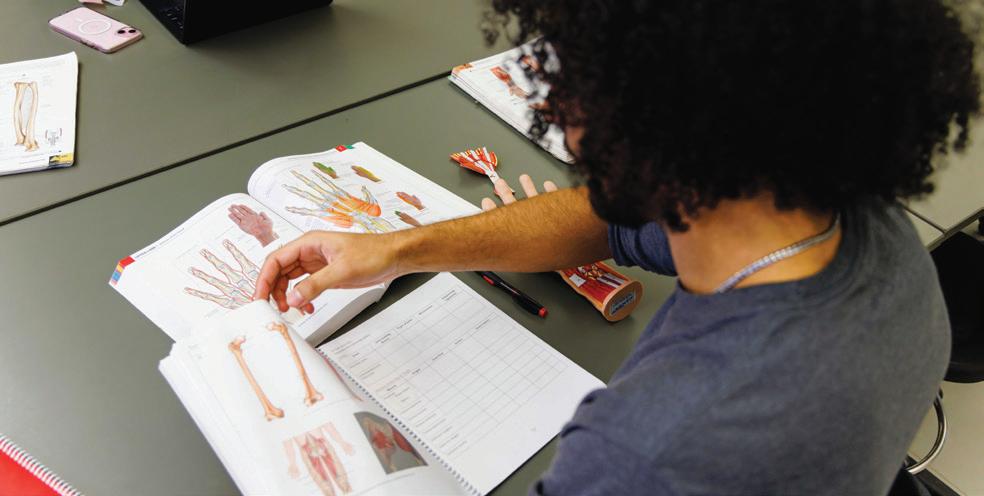
Faculty of Applied Health Sciences
Applied Health Sciences supports the priorities of the Institutional Strategic Plan: We deliver and develop high-quality undergraduate, graduate and professional programs, which meet the needs of students and the community; we promote and develop strong basic and applied research foci with outstanding researchers, research partnerships and excellent graduate and undergraduate student research opportunities; our expansive experiential education and practicum opportunities for undergraduate and graduate students along with our extensive network of community partnerships work synergistically to enhance the life and vitality of the Niagara region and beyond; and we prioritize curriculum revision, new program development and student/faculty recruitment and support, which fosters inclusivity, accessibility, reconciliation and decolonization. For more information on the FAHS, visit brocku.ca/applied-health-sciences
Note: Revenue includes $0.2 million ($0.2 million in 2024-25) funding related to Canada Research Chairs. See Figure 59-B for a breakdown of operating expenses by type.
Figure 59-B: 2025-26 Operating costs (%)
(1) Full-time equivalent (FTE) faculty/librarians represents Brock University Faculty Association (BUFA) probationary and tenured faculty and Associate Deans (both filled and unfilled positions). LTA/ILTA represents BUFA limited-term and instructional limited-term faculty appointments. Faculty on sabbatical are represented as one FTE.
(2) FTE – staff represents evaluated salaried staff positions (both filled and unfilled).
(3) See Figure 10 in 'The Big Picture' pullout for explanation of the figures reported.
(4) See Figure 11 in ‘The Big Picture’ pullout for explanation of the figures reported.
Figure 59-D: 2025-26 Budget personnel costs (including benefits) (%)
*Note: BUFA positions, BUFA overload and Associate Deans.
Figure 59-A
Figure 59-C

Goodman School of Business
The Goodman School of Business strives to fulfill its vision of creating meaningful, sustainable impact through our work in the classroom, in our community and through world-changing research. We are committed to providing students with exceptional experiences and providing them with the opportunities needed to succeed. In a supportive and collegial environment, our faculty pursue their research in ways that inform teaching, forward the interests of our communities, and propel our schools’ reputation. We are proud of our accreditations from the Association to Advance Collegiate Schools of Business (AACSB), the European Foundation for Management Development (EFMD) and Certified Public Accountants (CPA) of Ontario, among others, ensuring that our students receive an excellent business education that meets rigorous standards. Our international partnerships help students to gain a global perspective while our many clubs, competitions and co-op and experiential learning opportunities help our students develop leadership and work skills. Goodman is committed to our local community through our support for local businesses and offerings that address community needs. Our Goodman Group offers exclusive Executive Development programs that serve the broader business community with high-value certificate programs offering direct access to comprehensive programs designed to build leadership capacity. For more information, visit brocku.ca/goodman
Note: Revenue includes $0.6 million ($0.6 million in 2024-25) related to Goodman Group programming. An additional $0.2 million ($0 million in 2024-25) of Goodman Group programming revenue is shown as part of the Professional and Continuing Studies responsibility centre. See Figure 60-B for a breakdown of operating expenses by type.
Figure 60-B: 2025-26 Operating costs (%)
(1) Full-time equivalent (FTE) faculty/librarians represents Brock University Faculty Association (BUFA) probationary and tenured faculty and Associate Deans (both filled and unfilled positions). LTA/ILTA represents BUFA limited-term and instructional limited-term faculty appointments. Faculty on sabbatical are represented as one FTE.
(2) FTE – staff represents evaluated salaried staff positions (both filled and unfilled).
(3) See Figure 10 in 'The Big Picture' pullout for explanation of the figures reported.
(4) See Figure 11 in ‘The Big Picture’ pullout for explanation of the figures reported.
Figure 60-D: 2025-26 Budget personnel costs (including benefits) (%)
*Note: BUFA positions, BUFA overload and Associate Deans.
Figure 60-A
Figure 60-C

Faculty of Education
The Faculty of Education (FOE) is a leader in the delivery of academic programs related to learning and teaching across the lifespan. Award-winning faculty members are recognized for contributions to scholarship, creative activities and service, receiving titles such as Extra Ordinary or Distinguished Professors and earning lifetime achievement awards, Brock Teaching Awards of Excellence and/or 3M Teaching Awards. FOE collaboratively offers Indigenous Educational Studies programs to support teacher education in remote communities while forging education pathways for Indigenous adults in Ontario. FOE’s outstanding accredited Teacher Education programs respond to the needs of Ontario’s school boards, including French language and technological education. Early Childhood Education (ECE), a fully online program, is a pathway for ECEs to complete an honours degree. The Adult Education online programs have zero text cost to students in year-round study sessions. Programs online meet the needs of working professionals in a variety of teaching and learning contexts. Graduate programs (MEd, PhD) provide rigorous education for teachers and leaders in the education field. For more information, visit brocku.ca/education
Note: 2024-25 budgeted revenue includes $0.2 million of student fees related to Continuing Teacher Education. Starting in the fall of 2024, Continuing Teacher Education is reported as part of Professional and Continuing Studies. See Figure 61-B for a breakdown of operating expenses by type.
61-B:
(1) Full-time equivalent (FTE) faculty/librarians represents Brock University Faculty Association (BUFA) probationary and tenured faculty and Associate Deans (both filled and unfilled positions). LTA/ILTA represents BUFA limited-term and instructional limited-term faculty appointments. Faculty on sabbatical are represented as one FTE.
(2) FTE – staff represents evaluated salaried staff positions (both filled and unfilled).
(3) See Figure 10 in 'The Big Picture' pullout for explanation of the figures reported.
(4) See Figure 11 in ‘The Big Picture’ pullout for explanation of the figures reported.
(5) Starting in the 2024-25 Budget Report the enrolment figures no longer include Continuing Teacher Education. The prior year figures have been adjusted for comparability.
61-D: 2025-26 Budget personnel costs (including benefits) (%)
*Note: BUFA positions, BUFA overload and Associate Deans.
Figure 61-A
Figure 61-C
Figure
2025-26 Operating costs (%)
Figure

Faculty of Humanities
The world has changed utterly in the past few years, and those changes have been most apparent in their impact on the lives and spirits of individual human beings. That's where the Humanities come in. Our researchers and creative practitioners examine the cultural, historical and intellectual frameworks of the world and the human experience and have significant impact both locally and internationally. We work on figuring out what really happened or is happening, how we can know and what we can do about it.
We are the very embodiment of the Institutional Strategic Plan: Our students have an experience unparalleled in Ontario universities, both in the classroom and beyond, as they engage with the world and consider how to improve it. We enhance the life of our community through creative performances, exhibits and intellectual events, and we actively pursue inclusion and accessibility through our teaching, research, creative activity and service. Along the way, as well, we help inoculate against fake news and extremism by fostering a respect for rigour and truth in our teaching, scholarship and creative activity. For more information, visit brocku.ca/humanities
Note: Revenue includes $0.5 million ($0.5 million in 2024-25) of spending allocations from the Marilyn I. Walker School of Fine and Performing Arts Endowment Fund. See Figure 62-B for a breakdown of operating expenses by type.
(1) Full-time equivalent (FTE) faculty/librarians represents Brock University Faculty Association (BUFA) probationary and tenured faculty and Associate Deans (both filled and unfilled positions). LTA/ILTA represents BUFA limited-term and instructional limited-term faculty appointments. Faculty on sabbatical are represented as one FTE.
(2) FTE – staff represents evaluated salaried staff positions (both filled and unfilled).
(3) See Figure 10 in 'The Big Picture' pullout for explanation of the figures reported.
(4) See Figure 11 in ‘The Big Picture’ pullout for explanation of the figures reported.
Figure 62-A

Faculty of Mathematics and Science
The Faculty of Mathematics and Science (FMS) develops and delivers programs (many with a co-op option) and courses to provide knowledge and hands-on experiences that serve as a strong foundation for its students. FMS aligns with the Institutional Strategic Plan in many ways, especially by fostering a culture that focuses on multidisciplinary and transdisciplinary approaches (as seen in Neuroscience, Biotechnology, etc.); being a leader in bringing in funding from a wide range of sources to support research infrastructure and capacity; and having researchers' work in a wide range of areas with local and global impact, from pharmaceutical development to grape and wine innovation. FMS is also home to the Yousef Haj-Ahmad Department of Engineering. Since fall 2024, Brock is one of only three universities in Canada to offer Integrated Engineering, an approach to engineering education that addresses emerging needs and challenges in the engineering field. For more information, visit brocku.ca/mathematics-science
Note: Revenue includes $2.4 million ($1.7 million in 2024-25) of funding from strategic funds for Engineering and $0.1 million ($0.1 million in 2024-25) funding related to Canada Research Chairs. See Figure 63-B for a breakdown of operating expenses by type.
(1) Full-time equivalent (FTE) faculty/librarians represents Brock University Faculty Association (BUFA) probationary and tenured faculty and Associate Deans (both filled and unfilled positions). LTA/ILTA represents BUFA limited-term and instructional limited-term faculty appointments. Faculty on sabbatical are represented as one FTE.
(2) FTE – staff represents evaluated salaried staff positions (both filled and unfilled).
(3) See Figure 10 in 'The Big Picture' pullout for explanation of the figures reported.
(4) See Figure 11 in ‘The Big Picture’ pullout for explanation of the figures reported.
Figure 63-C
Figure 63-B: 2025-26 Operating costs
Figure 63-D: 2025-26 Budget personnel costs (including benefits) (%)
Figure 63-A

Faculty of Social Sciences
Brock's largest Faculty offers an exciting array of undergraduate and graduate programs that use different lenses to examine human behaviour and interaction to address urgent social challenges. The diversity of our subject areas encourages students to explore and develop a variety of interests, understand new perspectives and gain the valuable skills they need to change the world, including critical thinking, research, and the analysis and interpretation of data – all of which are essential to confronting the complex issues that societies face today and in the future. Highlights of our strategic investments that promote institutional priorities include programs and research that have a transdisciplinary focus; programming developed and revised in response to educational and career plans of potential students; and experiential education opportunities that bring together students and members of the Niagara community and beyond to exchange knowledge and build professional capacity for the many careers that stem from fields in the social sciences. For more information, visit brocku.ca/social-sciences
Note: Revenue includes $0.3 million ($0.4 million in 2024-25) funding related to Canada Research Chairs. See Figure 64-B for a breakdown of operating expenses by type.
(1) Full-time equivalent (FTE) faculty/librarians represents Brock University Faculty Association (BUFA) probationary and tenured faculty and Associate Deans (both filled and unfilled positions). LTA/ILTA represents BUFA limited-term and instructional limited-term faculty appointments. Faculty on sabbatical are represented as one FTE.
(2) FTE – staff represents evaluated salaried staff positions (both filled and unfilled).
(3) See Figure 10 in 'The Big Picture' pullout for explanation of the figures reported.
(4) See Figure 11 in ‘The Big Picture’ pullout for explanation of the figures reported.
64-D: 2025-26 Budget personnel
Figure 64-C
Figure 64-B: 2025-26 Operating costs (%)
Figure
Academic support
Faculty of Graduate Studies and Postdoctoral Affairs
65
(1) Full-time equivalent (FTE) faculty/librarians represents Brock University Faculty Association (BUFA) probationary and tenured faculty and Associate Deans (both filled and unfilled positions). Faculty on sabbatical are represented as one FTE.
(2) FTE – staff represents evaluated salaried staff positions (both filled and unfilled).
Faculty of Graduate Studies and Postdoctoral Affairs champions integrative graduate education as a gateway to independence and diverse career opportunities, built upon a foundation of mentorship, collaboration, transparency and merit. Our 55 graduate programs tackle contemporary challenges, pushing the boundaries of current thought and shaping the future across disciplines.
As the central academic and administrative hub for graduate education, the Faculty supports all graduate programs, playing a vital role in recruitment, retention and student success. By attracting top graduate talent, we drive Brock’s strategic priority of advancing research, discovery and knowledge.
The Faculty oversees every stage of the graduate journey – from applications, admissions and enrolment to funding, scholarships and professional development. We also work closely with Brock’s Graduate Council and the Senate Graduate Studies Committee to establish and uphold policies that shape the graduate experience. In collaboration with the Graduate Students’ Association, we advocate for student needs and foster a supportive academic community.
Aligned with Brock’s Strategic Plan, the Faculty is committed to building sustainable futures, strengthening communities and making a global impact.
For more information, visit brocku.ca/graduate-studies
Note: Revenue includes $0.4 million ($0.4 million in 2024-25) from the Ontario University Application Centre.

Figure
Library
66
(1) Full-time equivalent (FTE) faculty/librarians represents Brock University Faculty Association (BUFA) probationary and tenured faculty and Associate Deans (both filled and unfilled positions). LTA/ILTA represents BUFA limited-term and instructional limited-term faculty appointments. Faculty on sabbatical are represented as one FTE. (2) FTE – staff represents evaluated salaried staff positions (both filled and unfilled).
The Brock University Library enriches teaching, learning and research at Brock through collaborative expertise, rich content and inclusive spaces. The Library supports student success by providing the competencies, tools and resources that learners need to excel in a changing environment; advances knowledge by providing access to scholarly information and through active engagement in the research lifecycle; and inspires discovery by fostering creative engagement with technology. The Brock University Library includes the James A. Gibson Library; the Map, Data and GIS Library; the Archives and Special Collections; Burlington Campus Library and the Makerspace in the Rankin Family Pavilion. The Library comprises six departments and a staff of approximately 50, of whom 20 are professional librarians. The Brock Library's strategic plan has four strategic pillars highlighting student success, the research lifecycle, community engagement and strengthening capacity. For more information, visit brocku.ca/library
Note: Operating costs include $6.1 million of library acquisitions ($5.8 million in 2024-25).
Centre
for Pedagogical Innovation
(1) FTE – staff represents evaluated salaried staff positions (both filled and unfilled).
The Centre for Pedagogical Innovation (CPI) includes teaching and learning advancement and online learning.
CPI fosters a culture of excellence in teaching and learning across the University through supporting instructional staff and critical digital infrastructure.
CPI brings people together to explore effective teaching and learning practices as well as innovative pedagogies, both in the classroom and online. CPI also assists departments and instructors in the design, development and delivery of courses and programs.
For more information, visit brocku.ca/pedagogical-innovation
Figure
Figure 67
Research Enterprise
Figure 68-A
The Research Enterprise includes the Office of Research Services (ORS), Animal Care Services (ACS), the Office of Research Ethics (ORE), the Brock LINC innovation and entrepreneurship hub, and funding for transdisciplinary research and activities, including the Cool Climate Oenology and Viticulture Institute (CCOVI) and the growing Brock–Niagara Validation, Prototyping and Manufacturing Institute (VPMI). (Note: Costs related to the Office of the Vice-President, Research are included in the Academic and Executive Offices responsibility centre.)
The Research Enterprise supports Brock’s strategic priority of shaping tomorrow through research, discovery and knowledge. As a focal point for funders, industry, community groups and researchers, the Research Enterprise fosters connections and showcases Brock University as a centre of research excellence. The Research Enterprise units continuously strive to enhance service to researchers and the broader community by identifying opportunities for improving process efficiencies and reducing timelines. The 2025-26 budget includes measures to align services, internal program offerings and institute funding support levels, with Brock’s renewed Strategic Plan.
ORS supports researchers with shaping compliant and well-positioned grant proposals and administers contracts and funding. A major portion of the ORS budget is devoted to internal funding for research activities. ORE supports research involving humans and ACS supports research involving animals. The Brock LINC aims to foster a culture of creativity and innovation, grow entrepreneurship and support research innovation and capacity at the University, including through support for commercialization and intellectual property management. For more information, visit brocku.ca/research-at-brock
CCOVI is Brock’s long-standing flagship transdisciplinary institute. It defines a place within and beyond the University for research and networking to advance the Canadian grape and wine industry. Faculty, students and staff partner with academic communities, federal and provincial government research organizations and regional grape and wine industry groups across Canada, as well as cool climate wine regions around the world. For information about CCOVI, visit brocku.ca/ccovi
VPMI is Brock’s newest flagship transdisciplinary institute. It is a collaborative hub connecting Brock researchers and students with industry partners. It is rooted in a state-of-the-art technology adoption centre in the heart of Niagara’s bioproducts and chemical manufacturing clusters, providing industry with technological solutions and access to highly skilled talent while weaving seamless development and implementation of innovation into the production practices and processes of partner companies. For information about VPMI, visit brocku.ca/vpmi
Brock continues to support several other transdisciplinary research institutes, including Canada–Caribbean Institute, Lifespan Development Research Institute, Niagara Community Observatory, Posthumanism Research Institute and Social Justice Research Institute. Find out more at brocku.ca/ research-at-brock/institutes-and-centres
Note: Revenue includes $2.7 million of grant revenue related to the Research Support Fund ($2.7 million in 2024-25).
O ce of Research Services
Funding of internal research grants and institutes (including CCOVI and VPMI)
Faculty startup, recruitment, relocation
Animal Care Services
Brock LINC
O ce of Research
* The above
Figure 68-B: 2025-26 total costs (%)
Professional and Continuing Studies (PCS)
English as a Subsequent Language (ESL)
PCS includes non-credit program offerings (courses, workshops, micro-credentials and professional certificates) and custom training for organizations, delivered both in person and online. The non-credit offerings designed by PCS support career progression, skill development and personal growth by providing opportunities to broaden perspectives and enrich life through learning. In addition, starting in the Fall of 2024, Continuing Teacher Education is now supported through PCS. For more information about PCS, visit brocku.ca/ce
Note: Figure 69-B details total revenue by program. See page 21 for further discussion. 2023-24 actual revenue includes $1.1 million of strategic funding to offset start-up cost of PCS.
FTE – staff represents evaluated salaried staff positions (both filled and unfilled).
ESL, which operates as a unit within PCS, supports the Institutional Strategic Plan and Brock’s goals for internationalization. ESL Services is a path for international students and those with English as an additional language (EAL) to gain essential language skills, which either facilitates their successful participation in Brock’s undergraduate programs or provides a Canadian cultural language immersion for visiting international students. For more information about ESL Services, visit brocku.ca/continuing-education/esl

Figure 69-A
Figure 70
Figure 69-B: 2025-26 Revenue (%)
Student specific
Office of the Registrar and Enrolment Services
FTE
staff represents evaluated salaried staff positions (both filled and unfilled).
The Office of the Registrar and Enrolment Services (ORES) supports the Institutional Strategic Plan by providing a wide range of enrolment services that include student recruitment, admissions, frontline services (Brock Central), central academic advising, registration, curriculum management support, maintenance and enhancement of the student information system, scheduling of timetables and examinations, grade reporting, academic adjudication and degree audit, student transfers and
articulation agreements, and Convocation. It issues official academic documents and is responsible for maintaining the integrity of the University’s student academic record. For information on the Office of the Registrar, visit brocku.ca/registrar
Note: Revenue includes $1.6 million ($1.6 million in 2024-25) from the Ontario Universities' Application Centre and $0.2 million ($0.2 million in 2024-25) in grant revenue related to the Credit Transfer Institutional Grant. Operating costs include $1.0 million ($1.3 million in 2024-25) of contracted services mainly related to international student recruitment commissions. Student Recruitment Enrolment Operations and Supports Admissions Office of The Registrar Convocation
Figure 71-B: 2025-26 total costs (%)
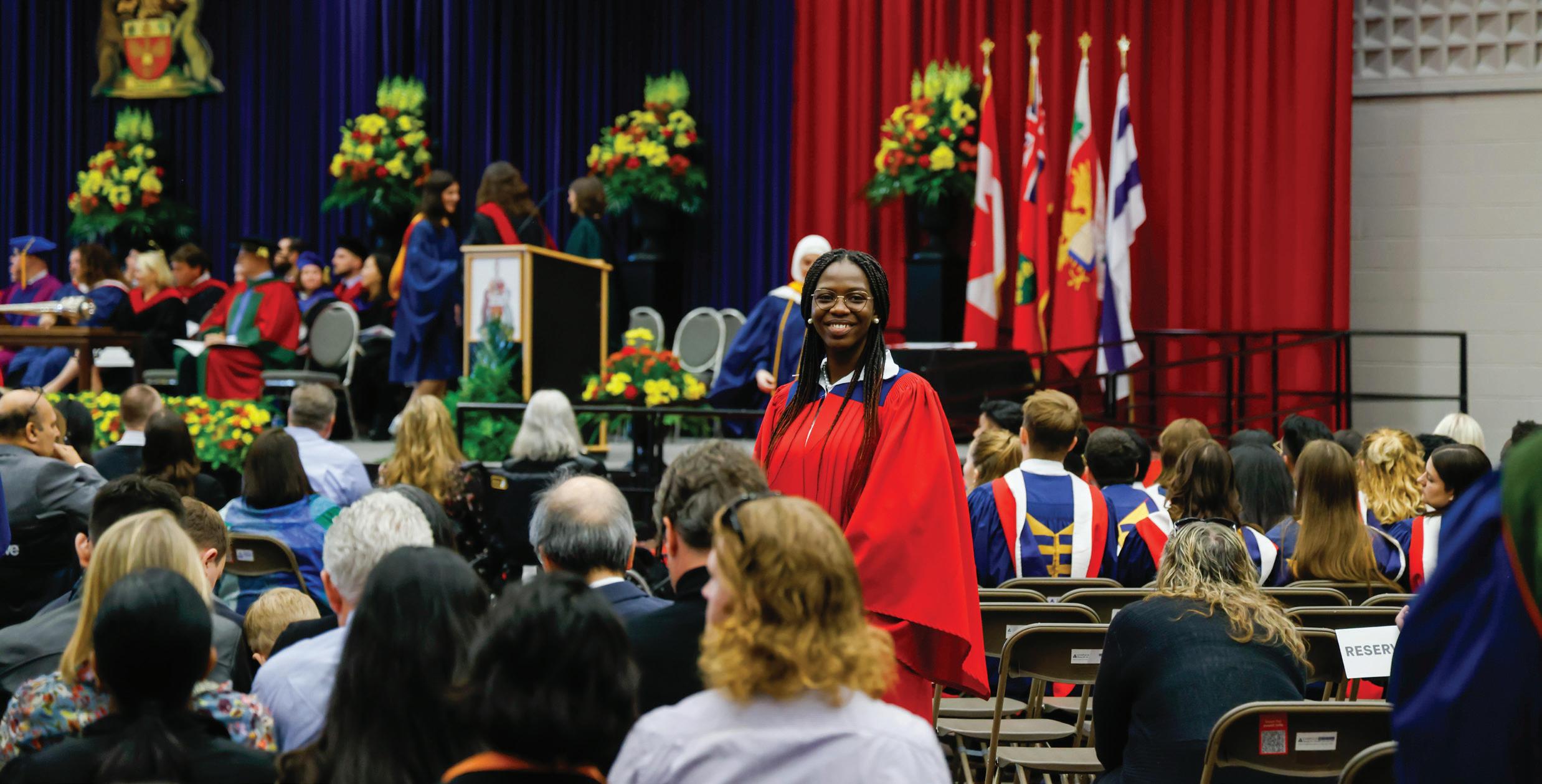
Figure 71
Student Wellness and Accessibility
The team at the Student Wellness and Accessibility Centre (SWAC) are driven by our mission to provide high quality health care, health education, counselling and accessibility supports to our Brock University students. The SWAC department is comprised of Student Health Services, Health Promotion, Personal Counselling Services and Student Accessibility Services. SWAC services align with Brock’s Strategic Plan by supporting a transformational and accessible academic and University experience; enhancing the life and vitality of our local region and beyond through community partnerships; and fostering a culture of inclusivity, accessibility, reconciliation and decolonization. Operations are supported through grants from BUSU, GSA and MCURES. For more information, visit brocku.ca/health-wellnessaccessibility
Student Accessibility Services supports students with disabilities in advocacy and supports for equitable access to the academic environment during their time at the University. Staff work alongside students to develop individualized academic accommodation plans; provide tailored and individualized support, such as learning and assistive technology strategies; and offer support in accessing and navigating campus life in liaison with University partners. The Student Accessibility Services office also supports faculty, instructors and departments in the implementation of accommodations and understanding of accessibility features and University responsibilities.
Student Health Services offers a diverse range of health-care services. Primary care is available to students at the main campus in two locations –DrugSmart and Harrison Hall. Health-care services include physical exams, sexual and reproductive
health, first aid for injuries, mental health care, gender-affirming care, injections, prescriptions, vaccinations and referrals to other health professionals and services. We also offer access to specialists including an ADHD specialist, eating disorder specialist and psychiatry.
Personal Counselling Services offers students individual and group counselling. These services are provided by professional therapists employed by Brock as well as contracted through purchase of service agreements with Telus Health. Personal Counselling Services also provides urgent counselling supports to students with one-time counselling sessions that can be booked online as needed.
The Health Promotion team provides information, programming and outreach for students in important aspects of student life, such as stress management, healthy relationships and physical and mental wellness. The Wellness Hub, a drop-in space for students, is operated by the health promoters as well as volunteer and paid students, giving students an opportunity to provide peer-to-peer support.
Note: Revenue includes $1.3 million ($1.3 million in 2024-25) of student ancillary fees and $1.1 million ($1.1 million in 2024-25) of grant revenue related to a number of MCURES grants, including the Access Fund for Students with Disabilities. Operating costs include $1.2 million ($1.2 million in 2024-25) of professional fees and contracted services, including physicians and counselling services.
Figure 72-A
Student Life and Success
Figure 73-A
For the purposes of the 2025-26 Budget Report, Student Life and Success (SLS) comprises the Black Student Success Centre (BSSC), Faith and Life, Learning Services, Student Life and SLS Operations, and Student Affairs. Student Life and Success shares responsibility with other campus partners for Brock’s strategic priority to offer a transformational and accessible academic university experience. SLS delivers a broad array of programs and services for all Brock students to support this priority and focus our work on five core actions:
1. Creating opportunities and spaces for student connection and community on and off campus.
2. Connecting to and partnering with our local community so that students can contribute and learn as engaged members of the Niagara region.
3. Engaging students in the learning process in support of academic success.
4. Promoting planning, health and safety for student events and engaging students in co-curricular experiential learning.
5. Holistically supporting students to develop critical competencies and signature strengths to flourish at Brock and prepare for life after graduation.
The Black Student Success Centre advances and celebrates Black, African and Caribbean student achievement and success. The BSSC is a welcoming and safe space for Black undergraduate and graduate students to gather, make connections and access key supports designed to support well-being and academic, personal and professional growth and development. The BSSC demonstrates Brock University's commitment towards Black Inclusion under the Scarborough Charter and supports the recruitment and retention of Black students. While the Black Student Success Centre is a Black-affirming space, it warmly welcomes and includes students from all backgrounds.
The Faith and Life Centre sustains a diverse, multi-faith community by encouraging cultural and religious literacy, creating opportunities for community building, and offering space for students to ask questions, seek counselling and grow – all vital elements of the student experience.
Learning Services supports students academically as they transition to and progress through their university life. Workshops and drop-in services are available and strategically positioned throughout the year to align with the pressures, and data-informed needs, that students face. Specialized learning programs such as Boost, Bridging and Stride are fine-tuned to unique student populations to support students in a “just-in-time, just-for-me and just-to-improve” methodology and with a prioritized focus on student persistence and success.
Student Life offers programs and services that impact student retention through offerings that connect students to one another, Brock's campus resources and the broader community. Student Life supports the holistic student experience through engagement in co-curricular learning opportunities, campus involvement, leadership development and mentorship, community volunteering, orientation programming, and off-campus living and neighbourhood relations.
Student Affairs is committed to providing a safe living and learning environment that promotes student success. The Student Affairs team is responsible for overseeing several policies and services, including supporting students-at-risk, administering the Student Code of Conduct and offering mediation services.
For more information, visit brocku.ca/student-lifesuccess
Note: Revenue includes $0.3 million ($0.3 million in 2024-25) of grant revenue related to the Ontario PostSecondary Access and Inclusion Program.
Figure 73-B: 2025-26 total costs (%)
Brock International
Figure 74
Brock International supports the Institutional Strategic Plan through the facilitation of strategic global partnerships and support services for Brock students and scholars.
Brock International is responsible for:
• Provision of programs, activities and services that support student well-being, success, career transition, settlement and immigration that are specifically tailored to the needs of the international student community.
• Developing partnerships and agreements that increase Brock’s global reach and engagement.
• Increasing access to global learning opportunities for students and scholars through exchange, mobility programs and international co-operation.
• Fostering a culture of inclusivity and community engagement.
For more information on Brock International visit brocku.ca/international
Hadiya'dagénhahs First Nations, Métis and Inuit Student Centre
Figure 75
(1) FTE – staff represents evaluated salaried staff positions (both filled and unfilled).
The Hadiya'dagénhahs First Nations, Métis and Inuit Student Centre (the Centre) is a space for all students to feel welcome. The Centre aids in cultural, social and academic supports and is committed to maintaining and enhancing Indigenous students' cultural identity in an academic setting. The Centre's team, and many community partners, work collaboratively to ease the transition to university by providing a safe and supportive environment throughout the learning journey. For more information visit brocku.ca/hadiyadagenhahs
Note: Revenue includes $0.3 million ($0.3 million in 2024-25) of grant revenue related to the Indigenous Student Success Fund and $0.2 million ($0.2 million in 2024-25) of student ancillary fees.

Co-op, Career and Experiential Education
76-A
FTE – staff represents evaluated salaried staff positions (both filled and unfilled).
Co-op, Career and Experiential Education (CCEE) supports the Institutional Strategic Plan, Brock Academic Plan and Strategic Mandate Agreement with the Ontario government. CCEE is the overarching department for student and new graduate employment, experiential education and career development and prepares job-ready undergraduate and graduate students for today’s diverse and everchanging labour market. The department consists of the following areas: Co-operative Education, Career Education (Campus and Goodman Career Education) and Experiential Education. This dedicated team of human resource, career development and experiential education professionals work with students, employers, faculty, community members and industry leaders to achieve operational and strategic goals that advance the mission of the University. For more information, visit brocku.ca/ccee
Co-op Education is a combination of integrated career development coaching and work opportunities that will enable students to explore career possibilities, gain new skills and build upon existing competencies. The co-op work experience will enrich one’s studies through reciprocal application of concepts and skills learned in class and during their work term, while developing long-term workplace efficacy. The Workplace Partnerships Team focuses on employer engagement and recruitment strategy, creating a one-door experience for employers looking to engage and hire student talent at Brock.
Career Education offers career exploration and development information and resources to support students and alumni. In addition, Career Education provides employers and community members with information and services about on-campus recruiting
and talent brand opportunities. Included in the Career Education unit is also Goodman Career Education.
Experiential Education promotes faculty, staff, students and community partners working together to provide opportunities for students to apply their classroom learning through hands-on experience. Undergraduate and graduate students reflect on their experiences to build skills, realize competencies, contribute to the community, prepare for their careers and build beneficial connections. Experiential opportunities include internships, placements, field courses, service learning, labs and more and are available in every Faculty at Brock.
Note: Revenue includes $2.1 million ($1.7 million in 2024-25) of co-op student fees. In addition, undergraduate co-operative education students pay tuition (applicable half-credit fee for each work term). However, like the Faculties, the revenue shown in the units does not include the allocation of Global tuition. Also included in revenue is $0.1 million ($0.1 million in 2024-25) of endowment fund from the Dr. Gerald B. Mitchell endowment fund. The 2023-24 actual revenue includes $1.1 million of grant revenue from the CEWIL Innovation Hub (iHUB), this is not included in the budget in 2025-26 or 2024-25.
Co-op Education and Workplace Partnership
Campus Career Education
Experiential Education
Co-op, Career and Experiential Education – Administration
Figure
Figure 76-B: 2025-26 total costs (%)
Brock Sports and Recreation
Figure 77-A
Brock Sports takes a leadership role and engages the community through sporting events and activities, tournaments, community partnerships and the Badgers Sports Camp programs. Badgers men’s and women’s teams provide more than 700 students with the opportunity to participate in Ontario University Athletics (OUA) and U SPORTS competitions. Brock Sports also runs the Brock Sports Performance Centre and the Brock Sports Medicine Clinic. For more information, visit gobadgers.ca
Brock Recreation provides programming for students including a wide variety of intramural activities, group and individual fitness programs, aquatics, open recreation opportunities, club sport programs for students and community, certification courses and leadership courses. The department also provides
community-based programming, including all levels of aquatic programs (learn to swim through competitive club swimming and lifeguard training), camps and programming for children and youth, school-based programs, and community adult memberships for aquatics and fitness. Brock Recreation is committed to providing an inclusive, accessible and respectful experience for all of its program participants, staff and volunteers while providing employment for more than 500 Brock university students. For information on programming, visit brocku.ca/recreation
Note: Revenue includes $4.0 million ($3.9 million in 2024-25) of student ancillary fees and $5.2 million ($5.2 million in 2024-25) of sales and services revenue, including program/activity and instructional fees related to school-based programs, Youth University camps, aquatics programs, other youth and community-based programming and intramurals, Badgers men’s and women’s teams, and Badgers Sports Camp programs. Operating costs include $0.6 million related to rental/ lease costs ($0.4 in 2024-25), including rental costs for using Canada Games Park.

Ancillary
Ancillary Services
Ancillary Services is comprised of Housing Services, Dining Services and Brock Card, Campus Store, Parking Services and Conference Services. Campus Development and Community Agreements, as well as Printing and Digital Services (described on pages 67and 62 of this report), are also managed as part of Ancillary Services.
Ancillary Services’ mission is to provide outstanding services that benefit the University community, with a vision of enhancing the University through engaged experiences. The four areas of focus are University customer experience, University contribution, quality products and services, and people and partnerships.
The budgeted Ancillary contribution for 2025-26 is $8.3 million, representing an increase of 10 per cent over the 2024-25 budget. This budgeted contribution is $1.2 million higher than set out the Fiscal Framework. Ancillary Services' budgeted capital contribution for 2025-26 is $4.1 million, which is consistent with the contribution set out in the Fiscal Framework; however, the allocation to a residence reserve is not included in the budget due to the current fiscal challenges in an effort to fund immediate deferred capital and renewal and maintenance (DCRM) needs. The funding of the residence reserve will be reinstated in the 2026-27 budget. This budget also includes funding of debt payments of $9.40 million ($9.41 million in 202425), which is consistent with the Fiscal Framework. There remains risk to Ancillary Services’ capacity to achieve their growth targets with declining enrolment impacting the volume of on-campus activity and demand for housing.
Campus Store
The Campus Store has faced significant external pressures that have resulted in sales declining by 40 per cent over the past 10 years. In fact, the 2023-24 Campus Store actual results showed a small deficit. To respond more efficiently to the changing needs of the Brock community while supporting the University’s overall financial sustainability strategy, Brock has entered into an agreement with Follett Higher Education, the largest campus store operator in North America, to assume operation of the Campus Store as of May 26, 2025. The store will continue to provide students with affordable textbooks, digital courseware, apparel, accessories, degree frames and gifts both online and in store. For more information, visit campusstore.brocku.ca
Conference Services
With an experienced team of conference co-ordinators, and facilities for every occasion, Brock Conference Services delivers exceptional experiences one event at a time. Focused on the customer experience, conference co-ordinators work with internal and external clients, making Brock University the ideal place to facilitate local, national and international conferences. Brock has become a particularly popular location for sporting events and conferences and in 2024-25, hosted the athletes’ village for the World Rowing Championships, resulting in an additional $2.2 million in budgeted revenue that year. For more information, visit brocku.ca/conference-services
Note: Conference Services’ revenue includes $2.2 million related to the World Rowing Championships athletes village in 2024-25.
Parking Services
As the first touchpoint for many campus guests, Parking Services issues permits, manages parking pay systems, facilitates special event parking, carries out parking lot enforcement and reviews ticket appeals on campus. Committed to excellent customer service, Parking Services works with partners across campus as well as local transit providers to ensure a positive, safe and accessible experience for all customers travelling to campus. For more information, visit brocku.ca/parking-services
Dining Services and Brock Card
Valuing healthy, high-quality and convenient food options to fuel the mind, as well as accommodating special dietary needs, Dining Services operates eight locations on campus as well as catering and vending. Dining Services also manages all food and beverage contracts with external vendors and brings new brands to campus to meet the needs of today's students. Dining Services is committed to providing seamless and comprehensive services and choices while supporting a healthy and sustainable university environment.
The Brock Card is the official identification (ID) card for students, faculty and staff at the University. The Brock Card functions primarily as Brock ID and as a payment card on campus and with community partners. The Brock Card also serves as a campus recreation centre membership card, a transit card (when affixed with a current bus pass sticker), a meal plan card, and a Residence key card as well as to control access to specific areas/buildings on campus.


Housing Services
During the academic year, Brock University houses nearly 2,800 students in its eight traditional, townhouse and semi-suite style residence buildings. The Housing Services team delivers vital support to Brock’s student population and encourages a sense of community that enhances the student experience.
In addition to first-year students, Housing Services offers accommodations for upper year and graduate students through Brock Suites, providing safe, convenient housing options to students beyond their first year.
Based on expected enrolment targets, Housing Services includes a budget of 97 per cent occupancy for 2025-26.
Over the spring and summer, when demand for student housing is lower, Brock’s residence buildings provide short-term overnight accommodations and are also employed in support of Conference Services.
For more information, visit brocku.ca/housing
Note: Operating costs include $1.9 million ($1.9 million in 2024-25) of annual lease payments; $0.6 million ($0.6 million in 2024-25) of direct utility costs and $1.6 million ($1.6 million in 2024-25) of utility costs charged back to Housing Services; $4.4 million ($4.4 million in 2024-25) of debt payments; and $1.5 million ($1.6 million in 2024-25) of repairs and maintenance and capital replacement costs.
Figure 79-A
Figure 79-B: 2025-26 total revenue (%)
Shared services
Academic and Executive Offices
Figure 80
As the University moves forward with the Institutional Strategic Plan, the University’s leadership is taking an active role in advancing the strategic priorities as set out in this plan.
Academic and Executive Offices, as defined in the 2025-26 budget report, includes the offices of: the President; the Vice-President, Administration; the Provost and Vice-President, Academic; the VicePresident, Research; the Vice-President, External; the Vice-Provost and Associate Vice-President, Academic; the Associate Vice-President, Students; the Vice-Provost, Indigenous Engagement; and the Vice-Provost, Teaching and Learning.
Information Technology Services
81-A
Information Technology Services (ITS) is a trusted partner in the University’s teaching, learning, research and administrative initiatives and in the broader Niagara community. Our mission is to foster collaboration and trust, develop and enhance a reliable technology-rich environment, provide secure and accessible systems, and continue promoting a service-oriented culture within ITS to support the Brock community. ITS is comprised of five teams: Infrastructure Technology, Client Services, Enterprise Transformation Office, Information Security and Enterprise Solutions.
For more information on ITS, visit brocku.ca/ information-technology
Note: Revenue includes $0.4 million ($0.4 million in 2024-25) of internal chargeback revenue related to the Residence Technology Fee. Operating costs include $1.5 million ($1.3 million in 2024-25) of repairs and maintenance and capital replacement costs.
Figure 81-B: 2025-26 total costs (%)
Figure
Financial Services
82-A
Financial Services is responsible for the efficient control, budgetary guidance and analytics of the financial activities of the University through development of the Fiscal Framework documents in support of the Institutional Strategic Plan. Financial Services also has shared responsibility for various operating units. Procurement Services, the Student Accounts and Financial Aid (SAFA) office, and Central Receiving and Mail Services are also part of Financial Services. For more information on Financial Services, visit brocku.ca/finance
Office of People and Culture
The Office of People and Culture (OPC) develops strategy and creates and administers programs, policies, and procedures to effectively manage the employee life cycle in the support of a sustainable, high-performing organization.
The team is organized in the portfolios of Talent Acquisition and People Development, Total Rewards and Payroll, Managerial Advising, Faculty and Labour Relations, People Systems and Analytics, and Health, Safety and Wellness.
To support Brock’s new Institutional Strategic Plan, the OPC strategy is structured under the following four key pillars:
• Organizational Culture and Employee Experience
• Equity, Diversity, Inclusion and Accessibility
• Employee Development and Growth
• Office of People and Culture Supports and Services
Our goal is to recognize the unique needs of our changing and diverse workforce and understand what employees want to achieve out of their employment at Brock, ensuring employees are equipped to effectively perform their roles and support the University in meeting its goals and objectives.
To learn more about the Office of People and Culture and how they support faculty and staff, visit brocku.ca/human-resources
Figure
Figure 83
University Marketing and Communications
84
University Marketing and Communications (UMC) provides the strategic direction for Brock University’s brand, marketing and communications efforts. As stewards of Brock’s brand and reputation, UMC tells the Brock story to the University’s many and varied audiences, including students, prospective students, staff and faculty, the community, industry, and the government. UMC’s key responsibilities include brand management, integrated marketing and communications, media relations and public affairs, social media, web and digital content development, and community engagement. For information, visit brocku.ca/marketing-communications
Development and Alumni Relations
Figure 85
The departments of Development and Donor Relations and Alumni Relations align with the Institutional Strategic Plan by raising funds for strategic priorities, including funding for the transformational student experience and enhancing research, as well as cultivating outstanding relationships with our alumni.
Development and Donor Relations is responsible for Brock’s philanthropic activity by working with donors who provide support for University priorities, including capital projects, teaching and learning, technology and student support. For more information, visit brocku.ca/development
Alumni Relations is responsible for alumni engagement and maintaining records for Brock’s network of more than 120,000 alumni worldwide. The department is dedicated to fostering a strong and lasting connection with graduates. For more information, visit brocku.ca/alumni
Figure 85-B: 2025-26 total costs (%)
Figure
Printing Services
University Secretariat
Printing Services is managed through Ancillary Services and provides both internal printing and the management of the fleet of multifunction copiers across campus. This area provides a wide range of print materials to meet academic, administrative and student print requirements. For information, visit brocku.ca/printing
Note: Revenue includes $0.6 million ($0.8 million in 2024-25) of internal charges to other departments.
FTE – staff (1) 5.0 5.0 (1) FTE – staff represents evaluated salaried staff positions (both filled and unfilled).
The University Secretariat supports the Institutional Strategic Plan by working to ensure the University’s two governing bodies (Board of Trustees and Senate) and their committees operate effectively and efficiently by providing governance expertise, research and analysis, and general support. The Secretariat has accountability for the University's policy framework and processes.
For more information on the University Secretariat, visit brocku.ca/university-secretariat
Note: The above chart also includes the operating costs of the Board and Senate.

Figure 86
Figure 87

Human Rights and Equity Services
Institutional Planning, Analysis and Performance
The Human Rights and Equity Office (HREO) supports the institution by providing members of the Brock community with information, education, programming, and complaint resolution support for concerns related to sexual violence, harassment, discrimination and human rights correlating to the Ontario Human Rights Code. For more information on Human Rights and Equity, visit brocku.ca/human-rights
Note: Revenue includes $0.6 million ($0.5 million in 2024-25) of student ancillary fees.
Institutional Planning, Analysis and Performance (IPAP) strives to be recognized as a leader in higher education for developing innovative analytics, informing data-driven decision-making and having an unparalleled culture of data governance and accountability. Through the collection, evaluation and organization of enrolment, survey and other institutional data, we translate campus data into useful information for the government, the Brock community and the general public. IPAP also provides analytics to support Brock's leaders in their pursuit of improving institutional effectiveness and overall student success. For more information, please visit brocku.ca/institutional-analysis
Figure
Figure 89
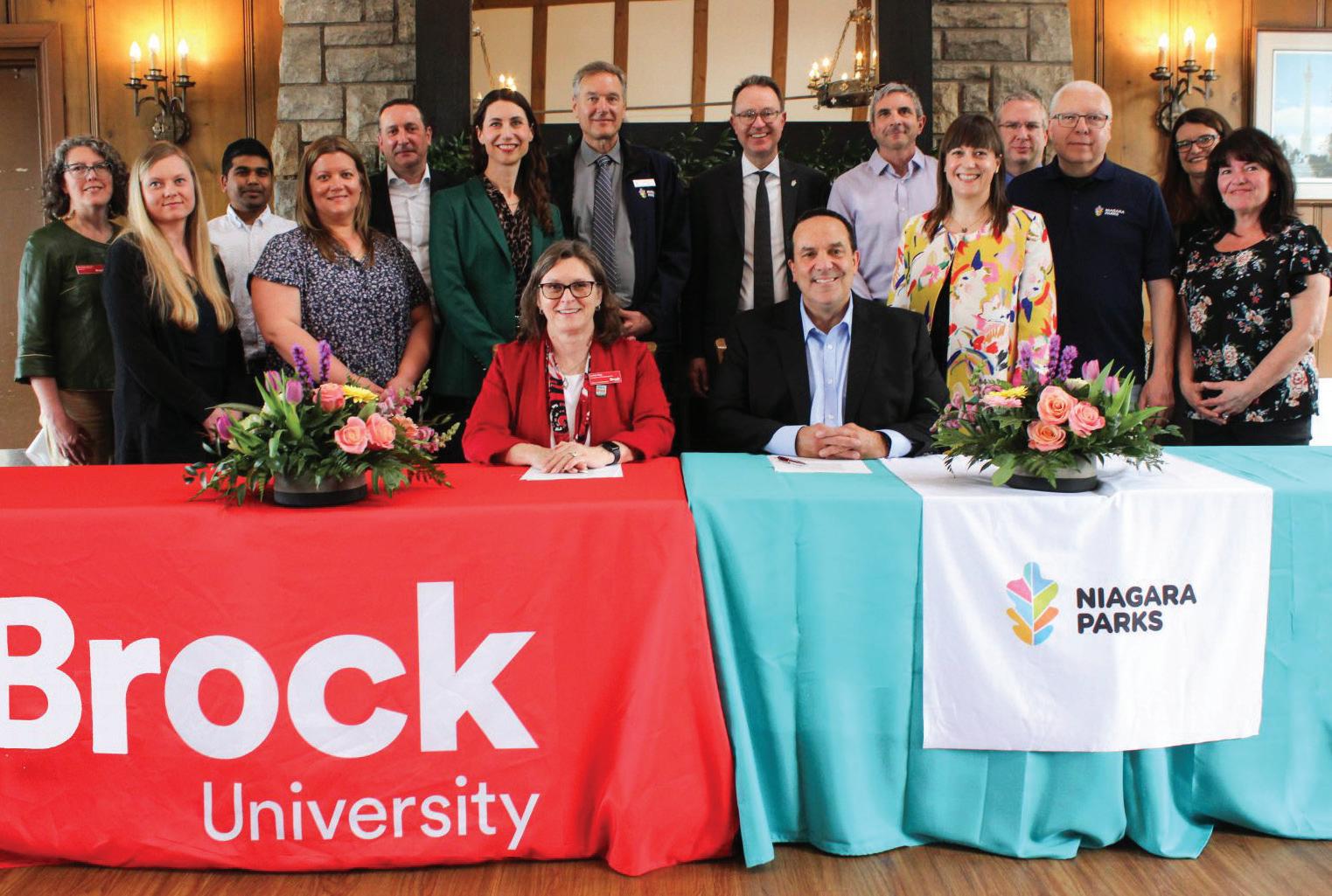
Office of Government and Community Relations
Figure 90
FTE – staff (1) 5.0 5.0 (1) FTE – staff represents evaluated salaried staff positions (both filled and unfilled).
The Office of Government and Community Relations builds relationships across all levels of government and with community organizations to advance Brock University’s strategic priorities, identify and respond to community needs, and raise awareness about the University’s unique areas of strength by:
• Monitoring and providing advice on public policy and programs.
• Developing, building and broadening relationships with elected representatives, non-elected officials and community partners.
• Supporting Brock’s government advocacy.
• Acting as a liaison and central point of contact for government and community initiatives and outreach.
• Coordinating strategic communications and community engagement efforts.
• Facilitating government and community visits to campus.
• Engaging with sector associations, including Universities Canada and the Council of Ontario Universities (COU).
• Matching community needs with University expertise to build capacity.
• Partnering with community organizations across the Niagara Region and beyond to help solve problems, generate research solutions and co-create knowledge.
• Enhance the culture of community engagement at Brock University.
• Oversee Brock’s institutional partnerships with community organizations through Memorandum of Understanding (MOU).
For more information on the Office of Government and Community Relations, visit brocku.ca/government-relations
Internal Audit and University Risk Management Legal Services
92
Internal Audit independently assesses the strength of the University’s risk-management and control processes. We support the achievement of the University’s guiding value of ensuring sustainable, accountable and transparent stewardship of public and private resources through traditional risk and controlbased reviews, assurance and compliance audits, project oversight and support, and investigations. University Risk Management, which includes the management of Brock’s insurance portfolio, supports the management of risks through a framework that identifies, assesses, monitors and reports on the status of the University’s principal risks. For more information, visit brocku.ca/internal-audit
The University’s Legal Services unit provides legal advice and support to the University to advance the mission and strategic priorities of the University while mitigating legal risks and promoting compliance with all legal and regulatory requirements. As part of this mandate, the Legal Services unit includes investigations services, managing and conducting investigations into allegations of harassment and discrimination. The Legal Services unit also oversees the administration of the University’s Freedom of Information and Protection of Privacy Act responsibilities and manages the University’s records management program. For more information, visit brocku.ca/legal
Figure 91
Figure


Space
Facilities Management
Figure 93
FTE – staff represents evaluated salaried staff positions and ongoing CUPE 1295 positions (both filled and unfilled).
Facilities Management supports the Institutional Strategic Plan by providing an exceptionally clean, safe, accessible and well-maintained physical environment for the University community by planning and developing services that are sustainable and supportive of academic excellence, including the sustainable operation of our District Energy System; facility maintenance; ground maintenance; capital planning, design and construction; project management; code and bylaw compliance; and cleaning and nonhazardous waste management. For more information, visit brocku.ca/facilities-management
Note: Revenue includes $0.7 million ($0.8 million in 2024-25) of revenue related to internal charges to other departments within the University, mainly salary chargebacks. Operating costs include $2.3 million ($2.2 million in 2024-25) of repairs and maintenance and capital replacement costs and $0.9 million ($1.2 million in 2024-25) of contracted services and professional fees, including maintenance, custodial and grounds contracted services. Utilities costs are not included in the Facilities Management budget and are reported as part of the 'Utilities, Taxes and Insurance' responsibility centre on page 68.
In addition to the budget reported in the Facilities Management responsibility centre, Facilities Management capital projects are budgeted in the Capital responsibility centre. Details of these expenditures can be found starting on page 74.
Campus Safety Services
94
Campus Safety Services is a dedicated team of experienced and skilled professionals who ensure the safety and security of the Brock Community along with all of its campuses and properties. We align our goals and objectives with the Institutional Strategic Plan to ensure the campus experience is engaging and meets the needs of our students, faculty, staff and visitors. We provide individual personal safety planning, threat assessments, teaching and learning opportunities, mentorship and support to meet the needs of the entire Brock community. Campus Safety Services is closely connected and in partnership with all external emergency responders to our campus in order to train and respond together for emergency preparedness and awareness. Campus Safety Services continues to work closely with all emergency responders and the Niagara Region Public Health unit. For more information on our services, videos and safety applications, visit brocku.ca/campus-security
Note: Operating costs include $0.9 million ($1.0 million in 2024-25) of contracted security services.
Campus Development and Community Agreements
95
Campus Development includes the rental revenue and related expenses for Heritage Plaza, which houses McDonald's, Tim Hortons, The Campus Pharmacy and Medical Clinic, and other retailers. Community Agreements include payments for community events, the First Ontario Performing Arts Centre and a transfer to BUSU for transit funding. Also part of this portfolio is budget related to the proportionate consolidation and other expenses for Canada Games Park in which Brock University is one-quarter owner and one-third operator.
Figure
Figure
Utilities, Taxes and Insurance Financing
Figure 96-A
97
The Utilities, Taxes and Insurance responsibility centre includes all centrally billed utility costs of $6.7 million ($6.7 million in 2024-25), including $0.8 million ($1.0 million in 2024-25) of federal carbon taxes.
This represents the majority of the University's total utility costs of $7.3 million ($7.3 million 2024-25). See Figure 55 on page 33 for details of utility costs. The remaining utility costs are billed directly to operating units. As detailed in Figure 96-B, offsetting these utility costs are chargebacks to Housing Services and external units to the University.
As further detailed in Figure 96-B, included in operating costs are municipal taxes (payment in lieu of property taxes), offset by the Grant in Lieu of Municipal Taxes. The remaining operating costs are made up of repairs and maintenance and capital replacement costs, the majority of which are related to the University's Central Utilities Building; insurance costs, contracted services and professional fees, and other operating costs.
The Financing responsibility centre includes the portion of the principal and interest payments of the University’s external debt, that is not included in Housing Services or in Ancillary Services. The budget includes principal payments of $2.6 million ($2.1 million in 2024-25) related to debt for 3401 Schmon Parkway and the Scotia loan. Interest of $7.5 million ($7.7 million in 2024-25) related to the debt for the 2045 $93-million debenture (2005 bond), the 2060 $125-million debenture (2020 bond), 3401 Schmon Parkway and the Scotia loan were included in the budget. Also included in this responsibility centre is additional contributions to the sinking fund for the 2020 bond and 2005 bond in the amounts of $0.9 million and $0.4 million, respectively ($0.9 million and $0.4 million in 2024-25, respectively).
For details on all interest and principal payments included in the budget, see Figure 56 on page 34. For a breakdown of the debt and more information on Brock’s financing strategies and all debt outstanding, see page 79.
The revenue in the Financing responsibility centre in the 2025-26 budget represents a transfer from Ancillary and Housing Services to fund $5.0 million ($5.0 million in 2024-25) of the University debt payments.
Figure
Figure
Scholarships, Bursaries and Fellowships
The Scholarships, Bursaries and Fellowships budget represents the majority of Brock’s undergraduate and graduate scholarships, bursaries and fellowships (SBFs). Of the total SBFs reported in this unit, $14.0 million ($15.0 million in 2024-25) relates to support for undergraduate students and $8.5 million ($8.5 million in 2024-25) relates to support for graduate students, including endowment-allocated scholarships and student awards.
Undergraduate
The undergraduate SBFs can be split into four main types: University-funded, those funded by government grants, student tuition waivers and those funded by endowments.
Total budgeted undergraduate University-funded SBFs of $10.3 million ($11.4 million in 2024-25) are either merit-based or need-based.
• Merit-based awards are budgeted to be $9.1 million ($10.1 million in 2024-25). Merit-based awards include Brock Entrance Scholars Awards of $3.0 million ($2.9 million in 2024-25) and renewals of those scholarships of $4.6 million ($5.6 million in 2024-25) as well as a number of other awards, including the International Student Ambassador Award, the Specialist High Skills Major Awards, the Niagara Principal’s Scholarship, Athletic Excellence Awards, etc.
• Need-based awards are budgeted to be $1.3 million ($1.3 million in 2024-25). These include funding related to the requirements of the Student Access Guarantee (SAG), an MCURES initiative that states that no qualified Ontario student should be prevented from attending post-secondary education because of a lack of financial support programs. The MCURES requires all colleges and universities that receive public funding to provide enough financial
aid to cover a student’s assessed needs for expenses directly related to his or her program that are not fully met by OSAP. Also included in need-based awards is Brock’s bursary assistance of $0.3 million ($0.4 million in 2024-25) as well several other specialty awards, including the Student International Mobility Awards, Emergency Bursaries, etc.
• Undergraduate student tuition waivers for Brock faculty and staff and their dependents are budgeted to be $1.3 million ($1.3 million in 2024-25).
Total grant-funded undergraduate SBFs for 2025-26 are budgeted to be $0.3 million ($0.2 million in 2024-25), which are directly offset with grant revenue.
The funding budget includes the endowment-allocated spend related to scholarships and student awards. The undergraduate portion for 2025-26 is $2.1 million ($2.1 million 2024-25). This support is shown in the budget as an inter-fund expense, with an offsetting inter-fund revenue of the same amount.
The following chart details the proportion of the total undergraduate SBFs (in this unit) by type – merit-based, need-based, tuition waivers, endowment-funded and grant-funded.
Figure 98-B: 2025-26 undergraduate scholarships, bursaries and student awards (%)
Figure 98-A
Brock Scholars and renewals
Graduate
The majority of graduate SBFs are in the form of University-funded fellowships of $5.9 million ($5.5 million in 2024-25). Other graduate SBFs of $0.9 million ($1.2 million in 2024-25) include Universityfunded entrance scholarships and awards for excellence, research awards and bursaries. In addition, there are scholarships funded two-thirds by the MCURES in the amount of $1.0 million ($1.0 million in 2024-25) with an offsetting grant revenue of $0.7 million ($0.7 million in 2024-25).
Also included in graduate SBFs are student tuition waivers for Brock faculty and their dependents and Brock staff, which are budgeted to be $0.2 million ($0.2 million in 2024-25).
As previously mentioned, the funding budget includes the endowment-allocated spend related to scholarships and student awards. The graduate portion for 2025-26 is $0.6 million ($0.6 million in 2024-25). This support is shown in the budget as an inter-fund expense, with an offsetting inter-fund revenue of the same amount.
The Capital responsibility centre represents the total funding of both the Facilities Management projects of $4.6 million ($4.2 million in 2024-25) and the Information Technology Services projects of $5.1 million ($4.9 million in 2024-25) in the capital and related project budget. Offsetting these costs is the contribution from Ancillary and Residence to the capital and related project budget of $4.1 million ($4.1 million in 2024-25). Also included in revenue is Facilities Renewal Program Funds of $4.2 million ($3.6 million in 2024-25). See page 27 for a discussion of these funds. See pages 74 to 77 for details of the capital and related project budget.

University Global
University Global represents those costs and revenue that are University-wide and are not budgeted for by any Faculty or department, including the majority of student tuition, MCURES operating grants and anticipated salary increases that haven’t yet been awarded. Full details of the University Global costs and revenue are described below.
Revenue for University Global includes the following:
• Tuition of $164.4 million ($174.6 million in 2024-25) as detailed in Figure 36 on page 20.
• Grant revenue of $107.8 million ($95.0 million in 2024- 25) as follows:
- Core Operating Grant of $34.5 million ($34.5 million in 2024-25) – see page 25.
- Differentiation Envelope of $53.2 million ($53.2 million in 2024-25) – see page 25.
- Nursing grant of $8.0 million ($6.0 million in 2024-25) – see page 27.
- Postsecondary Education Sustainability funds –base of $4.4 million ($2.6 million in 2024-25) – see page 25.
- Postsecondary Education Sustainability funds –top-up of $3.0 million ($0 million in 2024-25) – see page 25.
- STEM Sustainability grant of $4.4 million ($0 million in 2024-25) – see page 26.
- Initial Teacher Education grant of $1.2 million ($0 million in 2024-25) – see page 26.
- Niagara Region Brock LINC grant of $0.2 million ($0.2 million in 2024-25) – see page 28.
- International Student Recovery Fee offsets grant revenue of $1.1 million ($1.6 million in 2024-25) –see page 27.
• International Student Recovery Fee of $1.1 million ($1.6 million in 2024-25), which offsets the reduction mentioned above in grant revenue.
• Interest on short-term investments of $2.2 million ($2.2 million in 2024-25).
• Other revenue of $3.6 million ($4.3 million in 2024-25) which includes student interest income and an estimate of unclaimed student credit balances.
Personnel costs for University Global include salary and wage increases that are anticipated but not yet awarded or negotiated. Offsetting these costs are budgeted savings from voluntary vacation buy back.
Operating costs costs for University Global include University memberships, allowances for uncollectable funds, payment to Niagara College related to its share of the GAME program and other University-wide expense items. Note: When the 2024-25 Budget was established it included $1.9 million of strategic discretionary funding, which was subsequently used to fund strategic positions filled during the year at which time the budget was moved to the respective units. These adjustments are detailed in Appendix B of this report.
Figure 100

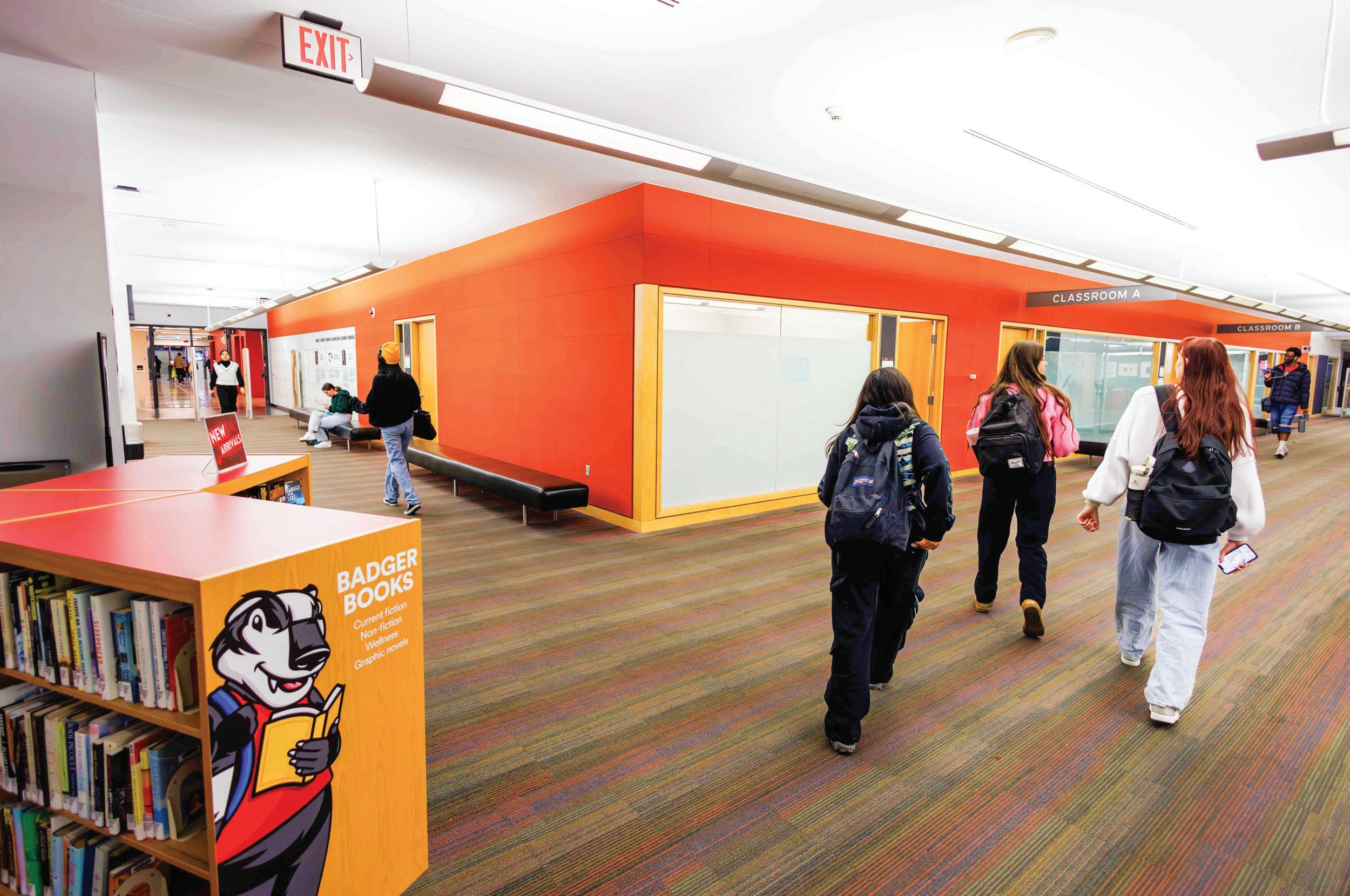
The following charts present two different ways of examining space at the University. Figure 101 details the space usage by category as of 2022, which was prepared for the Council of Ontario Universities’ Survey of Physical Facilities, as well as an updated estimate for 2025. Only 70 per cent of the University’s space is assignable to specific functions, while 30 per cent is non-assignable, meaning it relates to items such as utility plants, corridors and hallways. Figure 102 details the Deferred Capital Renewal and Maintenance (DCRM) backlog by asset type and compares this to the replacement value of those assets. This information was obtained from the condition assessment performed by SLAM Technologies Inc. (through Council of Ontario Universities) in May 2024, which determined Brock has $391 million in DCRM requirements that have accumulated over a number of years. In addition, the chart details the Facility Condition Index (FCI) (DCRM divided by the current replacement value), which determines the relative condition of the asset. The lower the FCI, the better the condition of the asset. For example, MIWSFPA has a low FCI, while buildings with higher FCIs are generally older, such as the Schmon Tower and the Walker Complex. Brock’s overall FCI is 0.23, while our goal is to maintain a FCI of 0.18.
Figure 101: Space usage
(1) The 2022 data was prepared for submission to the Council of Ontario Universities Triennial report that takes place every three years. The data is as of November 1, 2022. The estimate for 2025 was updated after the original submission and is included as an updated comparison to the 2022 data.
(2) NNASM includes items such as central utilities plants, corridors, stairwells, elevators, service tunnels and parking structures.
Figure 102: DCRM 2024
Capital and related projects budget
Background
The capital and related project budget was presented to the Board of Trustees for approval at the meeting on December 4, 2024, after input gathering from across the Brock community. Approving the capital and related projects budget in late November or early December allows Facilities Management and Information Technology Services time to start planning the projects so, where possible, they can be accomplished in the spring and summer when the campus is less busy, as well as to ensure there is sufficient time to obtain competitive pricing.
The process to develop this capital and related project budget began in the summer of 2024, when Facilities Management and Information Technology Services first published proposed projects and sought input. Further discussions were held at committee levels, including the Senate Information Technology and Infrastructure Committee and the Senate Planning, Priorities and Budget Advisory Committee.
Information and updates on the 2024-25 capital and related projects can be found in the 2024-25 trimester reporting at brocku.ca/about/university-financials. A key feature of this capital and related project planning is that any unspent funds of the 2024-25 capital and related projects budget will be reserved at April 30, 2025, and be moved into fiscal 2025-26 so the projects can be completed.
Capital and related projects overview
The 2025-26 capital and related projects budget (capital plan) is $9.7 million (Information Technology Services Projects – $5.1 million; Facilities Management Projects –$4.6 million). The specific projects are detailed in Figures 105 and 106.
As shown in Figure 103, the funding of the capital plan is made up as follows: $5.5 million is funded by the operating budget, both Ancillary ($4.1 million) and other global revenue contributions ($1.4 million), and $4.2 million is funded from Facilities Renewal.
Facilities Renewal Program –$4.220 million
Ancillary Contribution –$4.083 million
Non-ancillary contribution –$1.397 million
It is important to note that the 2022-23 Fiscal Framework set out targeted capital plan funding of $14.9 million for 2025-26. Due to the current financial environment, $5.2 million of funding from global revenue sources for the capital plan was removed from the 2025-26 capital and related projects budget.
The 2025-26 capital and related projects budget identifies key areas of investment, including core subscriptions, PCI and security compliance and subscriptions ($2.2 million), critical HVAC repairs, compliance and upgrades ($1.2 million), Identity Access Management and Security Operations center ($0.8 million), Learning Management System ($0.5 million), Campus Network and Wireless Capacity Upgrades ($0.8 million) and classroom modernization and renewal ($0.5 million). The capital plan includes $4.3 million in deferred capital renewal and maintenance (DCRM) spending.
Figure 103: Capital Budget funding source (%)
The primary driver informing much of the Facilities Management campus planning regarding DCRM has been the condition assessment currently performed by SLAM Technologies Inc. through the Council of Ontario Universities (COU), which maintains a common reporting tool to track facilities conditions across Ontario universities for DCRM reporting.
The condition assessment report (May 2024) by SLAM Technologies Inc. determined the University has $391 million in DCRM requirements (including residences) that have accumulated over a number of years. Although this level of maintenance is not obviously apparent when walking the halls of the University, the reality is that much of the DCRM is related to HVAC, electrical, plumbing and accessibility. An important observation is that this DCRM figure does not include information technology. The specific classifications of areas of DCRM are included in Figure 104.
The Facility Condition Index (FCI) metric provides a methodology to determine the relative condition of a single building, group of buildings or total facilities and is calculated by dividing the DCRM backlog by the current replacement value. The lower the FCI, the better the condition. Brock’s backlog of DCRM items, as described below, results in the FCI for Brock of 0.23, which translates to “Poor” (an FCI > 0.15).
Looking back over the past years, the turning point of the capital program really occurred when the Board of Trustees endorsed a motion to invest $6 million in deferred maintenance (now termed DCRM) in the 2014-15 budget. The intent of the $6-million contribution was to at least maintain DCRM and FCI at its current level. The 2022-23 Fiscal Framework re-established the commitment to fund DCRM of at least $6 million annually. While the DCRM spending included in the 2025-26 capital and related project budget of $4.3 million does not meet this fiscal framework target, DCRM projects were prioritized and it was ensured that the full Facilities Renewal Program funding was utilized.
In addition to the 2025-26 capital and related projects budget, other units maintain significant capital replacement and repairs and maintenance budgets. The Facilities Management budget includes $2.3 million, Housing Services has $1.5 million, other Ancillary Operations have $0.9 million, the Information Technology Services budget has $1.5 million and other units across the University have a total of $3.8 million included as part of their operating costs. These budgets support building, mechanical, electrical and ground maintenance projects ranging from elevator maintenance to door repairs to upgrades in equipment and technology.
(1)
Figure 104: COU VFA Data (as at May 2024)
Source: SLAM Technologies Inc. Facility Asset Condition Database.
Satellite campuses: Includes Brock Research and Innovation Centre and the Marilyn I. Walker School of Fine and Performing Arts.

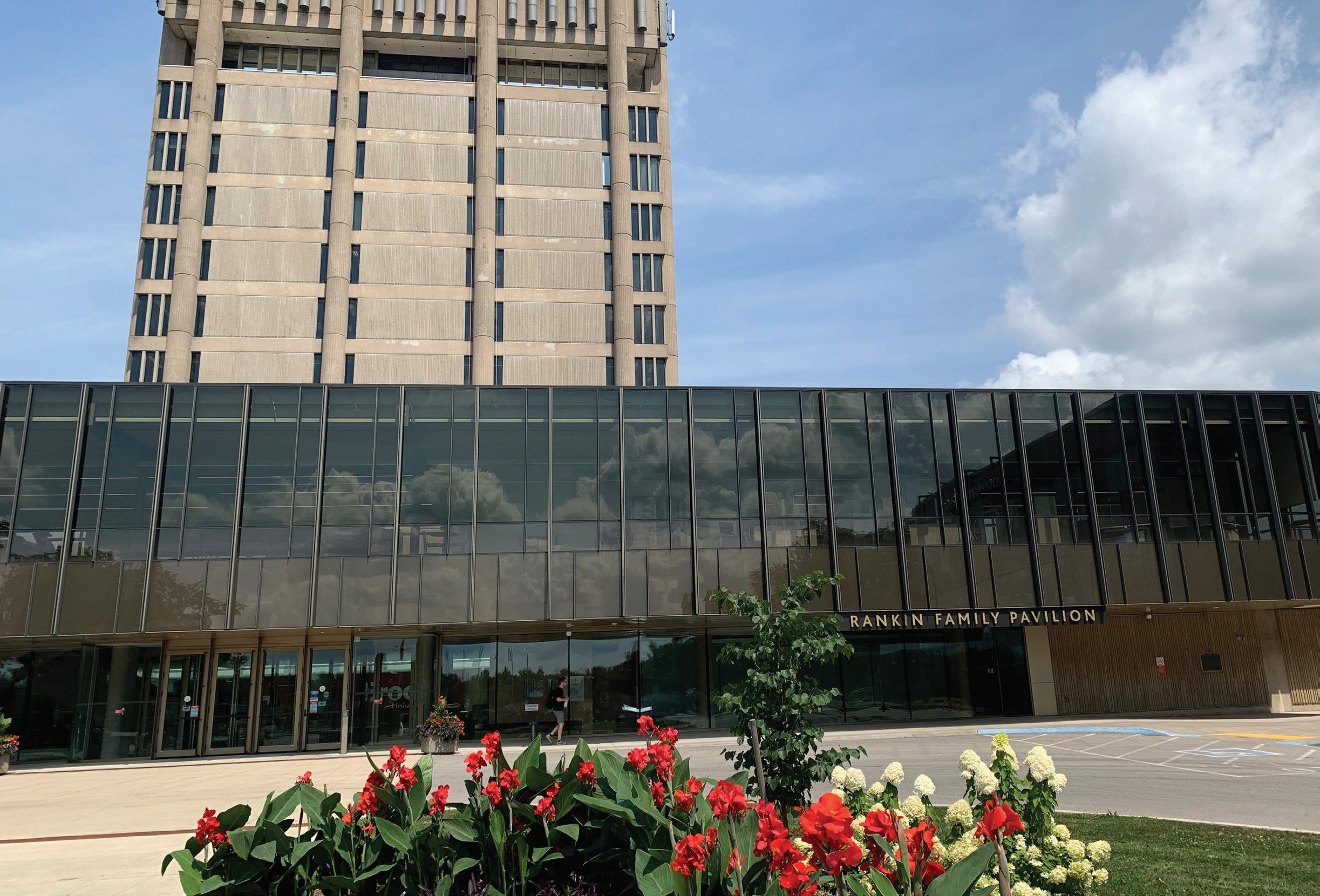
Financing
Figure 107 details the current and projected external debt of the University, which is within financial metric ranges of the University’s current credit rating. The 2022-23 Fiscal Framework Update continues with the holistic approach to Brock’s capital financing strategy that allows for decisions to be made in support of strategic priorities in a fiscally sustainable manner. Maintaining the University’s credit rating at A (high) or better is a strategic priority that remains in the Fiscal Framework. The impact on the University’s credit rating will be considered for any new debt and will be supported by a complete repayment plan, including Board-approved assumptions for sinking fund strategies if required.
Morningstar DBRS maintained Brock’s credit rating on Feb. 21, 2025, with the Issuer Rating and Senior Unsecured Debentures rating of “A (high),” with a trend of “Stable.” The continued trend of “Stable” reflects Morningstar DBRS’s positive outlook regarding Brock’s financial track record as it notes
“sound fiscal management and transparent financial reporting” as one of Brock’s top three fiscal strengths. Morningstar DBRS does note in its Rating Report that “the credit ratings remain constrained by the current challenging operating environment, which can be characterized by the restrictive funding and tuition framework and recent changes to federal immigration policy negatively affecting international student enrolment.”
The existing sinking funds for the Series A Debenture issued in 2005 and the Series B Debenture issued in 2020 continue to grow ahead of schedule due to strong investment returns. The existing sinking funds required operating budget contributions to begin in 2024-25, which have been included in the 2024-25 and 2025-26 budgets. The operating budget contributions accelerate in 2028-29 with the debt cost for the Sunlife Residence Loan being repurposed into the sinking fund when it is fully repaid.
(1) Fiscal full-time enrolment (FFTE). For a definition, refer to page 84.
Figure 107: Outstanding debt
Brock’s debt strategy is analyzed in Figure 108, which compares Brock’s key debt metrics to that of other universities in our comprehensive category as well as the MCURES financial sustainability metric minimums.
Figure 108: Financial health metrics
(1) Calculated using financial information from 13 comprehensive universities. Certain 2023 metrics have been updated due to revisions in certain universities' financial statements.
(2) The $20-million repayment of the Roy and Lois Cairns Health and Bioscience Research Complex load during 2022-23 causes the one-time swing in this metric.
Appendix F provides full definitions for each financial health metric.
The following details a high-level explanation of our debt metrics.
• The first two ratios describe how Brock utilizes a greater proportion of its annual operating expense to fund debt obligations.
• The interest coverage ratio measures the ability to fund interest charges from cash generated through operations. In 2024 it has dropped below the guidance of 2.00 set by the Board of Trustees and the ratio of 2.50 considered to be the standard by Morningstar DBRS for Brock’s current credit rating of A (high).
• The viability ratio is essentially how much of the institution’s debt could be paid off with expendable resources. The average institution in our category could pay all its debt with expendable resources, whereas Brock can only pay off 39 per cent and is therefore vulnerable to unplanned events.

Endowment summary
The funding budget includes the full endowment-allocated spend related to undergraduate and graduate scholarships and student awards. This support is shown in the funding budget as a funding source (interfund revenue) with the offsetting expense (inter-fund expense). The endowment fund policy can be found at brocku.ca/policies
The full activity of the endowment for the past three years is shown in Figure 109. Figure 110 details the 2025-26 approved endowment spending of $3.7 million, which includes both the student awards spending allocations as well as the operating and capital.
Figure 110
Includes the MIWSFPA endowment spending allocation, which can be used for both capital and operating.
Figure 111 details the Top 10 endowments as of April 30, 2024. Due to the timing of preparing and approving this budget, the information presented is as of April 30, 2024. This information will be updated for April 30, 2025 and incorporated into the University’s 2024-25 Annual Report.
Figure 111: Top 10 endowments (April 30, 2024)
Figure 109
Revenue and expense allocation model
The revenue and expense allocation model was developed through a consultative process with allocation methodologies approved by the Deans and the Provost. The model has three key functions to support academic and financial planning of the University:
1. Enhances the understanding of how revenues are generated and how costs are incurred and allocated at the Faculty level in a transparent manner.
2. Supports longer-term resource allocation decisionmaking for academic units.
3. Establishes an incentive mechanism to ensure yearend surplus funds are allocated to the Faculties and to support institutional strategic priorities.
The model has certainly improved understanding of University activities from a financial perspective and reinforces the interdependence of all Faculties and support units, building a culture of unity. Unspent funding is allocated back to Faculties in accordance with the terms of reference approved by the Provost and Deans. These allocations support strategic priorities of the Faculties consistent with the Institutional Strategic Plan.
Figure 112 is a visual representation of the 2025-26 budget using the details of the revenue and expense allocation model shown in Figure 117. This model reports the full operating budget and portrays expenses as a percentage of revenues allocated to each Faculty and in total. The model identifies two Faculties generating net positive contributions and four Faculties requiring additional funding from these positive contributions to support their operations. Through guidance from the Strategic Academic Leadership Team (SALT), this model reports all tuition allocated to the course students take and the Faculty the course belongs to, regardless of a student’s home Faculty. Taking a student-centric approach, allocating tuition based on a 100 per cent students-in-seats model, facilitates the ongoing review of academic program requirements and supports increased flexibility in programs for students to take additional elective credits.
Going forward, the model will continue to be evaluated and adjustments to the model will be made, in consultation with the SALT, where appropriate to ensure the model is meeting its goals as well as supporting the Institutional Strategic Plan.
Figure 112: 2025-26 Budget costs as a percentage of total revenue
(1) See page 39 for units included in Space Costs. Note: Space Costs are allocated directly to Faculties in this section. The space costs related to Academic Support, Student Support and Shared Services units are included in the respective lines in the allocation model. (2) Excludes Research Support Fund grant revenue as shown separately as part of revenue. (3) See pages 38 and 39 for details of units included in these categories.
Appendix A
Enrolment definitions
The following are measures of enrolment, as reported in this budget report.
• All-in enrolment: Includes degree-seeking, non-degree-seeking and certificate programs.
• Degree-seeking: A student seeking either a bachelor’s degree, a first professional degree, or a graduate master’s or PhD degree.
• Non-degree-seeking undergraduate: Those on a Letter of Permission, those auditing a course/ program or someone enrolled in undergraduate courses but with no program declaration.
• Full-time equivalent (FTE) enrolment: One undergraduate fiscal FTE (FFTE) represents a student whose study load in the fiscal year is equal to the normal full-time study load for their program and level of registration in the academic year. Undergraduate student FFTEs are summed over all academic terms. One graduate FTE is based on the registration level, full time or part time, of a student for an academic term; full time = 1.000 FTEs, part-time = 0.300 FTEs. Graduate student FTEs are summed over Fall and Summer academic terms. This methodology aligns with the studentbased FTEs reported to the Ministry and ensures that a single student, whether undergraduate or graduate, is treated equally as a full-time equivalent. Undergraduate FFTEs and graduate FTEs, when considered in combination, are termed FTEs. Note: Certain new-entry Winter registrations were also added to FTEs to more accurately reflect actual and budgeted tuition.
• Fiscal full-time equivalent (FFTE) enrolment: Graduate FFTEs are equal to graduate FTEs; however, they are summed over all academic terms. Undergraduate FFTEs and graduate FFTEs, when considered in combination, are termed FFTEs.
• Eligible FTEs: Those that are associated with programs or students that are approved by the Ontario government for funding purposes. Certain categories of students are ineligible (international, additional qualification and co-op on work term being the three largest groups).
• Headcount enrolment: A snapshot of the number of individuals who are attending the University at a particular point in time, usually Nov. 1 of each Academic Year, and the response to the commonly asked question: “How many students does Brock have?”
• Weighted grant units (WGUs): WGUs are used in reporting enrolment to the Ontario government for funding purposes and represent a weighted enrolment measure. The WGUs for Brock University range from 1.0 for General Arts to 3.2 for PhD students.
Appendix B
Summary of budget adjustments
As a result of certain changes in preparing the 2025-26 budget as well as changes that occurred during the 2024-25 year, reclassifications were made to the 2024-25 budget as reported in the 2024-25 Budget Report for comparison purposes when the overall funding budget was not impacted. Figures 114 and 115 detail these reclassifications by function and by responsibility centre with the most notable reclassifications highlighted with explanations. Faculty and staff full-time equivalent (FTE) impacts related to the adjustments are also shown in Figure 115.
Reclassifications by function
• During 2024-25, the Zone Expansion fee was removed from the operating fund and will be recorded directly as deferred capital contributions to better align with accounting standards. This change resulted in a decrease of student fees and inter-fund expense by $1.5 million each.
• During 2024-25, budgets for positions of $2.1 million were established. These positions were funded from operating strategic funds, $1.9 million (offset in other operating costs), as well as funding from other sources of $0.2 million with offset showing in grant revenue, inter-fund revenue, other revenue and other operating costs.
• During 2024-25, new student program fees that were budgeted in Applied Health Science were moved from other revenue to student fees in the amount of $0.37 million.
Figure 114: Reclassifications by
Agrees to the 2024-25
function
Figure 115: Reclassifications by responsibility centre
($000s)
Teaching Faculties
Faculty of Applied Health Sciences (30,684) (333) (31,017) 1.0
Goodman School of Business (29,372) (100) (29,472) 0.3
Faculty of Education (18,830) (183) (19,013) (0.7)
Faculty of Humanities (25,146) (72) (25,218)
Faculty of Mathematics and Science (24,833) (129) (24,962) 1.0
Faculty of Social Sciences (42,369) (2) (42,371) (1.0)
Total Teaching Faculties (171,234) (819) (172,053)
Academic Support
Faculty of Graduate Studies and Postdoctoral Affairs (1,779) (50) (1,829)
English as a Subsequent Language (ESL)
(7)
Total Academic Support (18,467) (367) (18,834)
Student Specific Office of the Registrar (6,411) (196) (6,607)
Student Wellness and Accessibility (1,804) (371) (2,175)
Hadiya'dagénhahs First Nations, Métis and Inuit Student Centre (15) (15)
(1) Agrees to the 2024-25 Budget Report
Reclassifications by responsibility centre
• During 2024-25, $2.0 million of personnel rate increases were allocated from the University Global responsibility centre to other units as these specific amounts were not known at the time of preparing the 2024-25 budget. This total related to salary increases to administrative/professional, OSSTF, CUPE 4207 Unit 4 and SAC staff.
• During 2024-25, budgets for positions of $1.9 million were established and funded from the operating strategic fund in the following units, with the noted
Figure 115: Reclassifications by responsibility centre (cont'd)
Shared Services Academic and Executive Offices (1)
increases to their budgets and FTEs: Faculty of Applied Health Science $0.12 million; Goodman School of Business $.04 million; Faculty of Education
$0.04 million; Faculty of Mathematics and Science $0.14 million; Library $0.09 million; Research Enterprise $0.09 million; Professional and Continuing Studies $0.08 million; Office of the Registrar $0.08 million; Student Wellness and Accessibility $0.32 million; Student Life and Success $0.10 million; Co-op, Career and Experiential Education $0.16 million; Academic and Executive Offices $0.09 million; Information Technology Services $0.15 million; Development and Alumni Relations $0.32 million; and
Human Rights and Equity Service $0.09 million offset by a decrease in University Global of $1.9 million. In addition, positions moved from the Faculty of Mathematics and Science and the Faculty of Social Science to Information Technology Services ($0.20 million) as well as from Information Technology Services, Facilities Management and the Academic and Executive Offices to Legal Services ($0.06 million) during the year.
• Starting in the Fall of 2024-25, Continuing Teaching Education moved from the Faculty of Education to Professional and Continuing Studies in the amount of $0.14 million.
• During 2024-25, the remaining budget related to the Instructional Resource Centre moved from the Faculty of Education to the Library in the amount of $0.06 million.
• During 2024-25, Strategic Partnerships and Events was moved from Brock International to the Academic and Executive Offices in the amount of $0.45 million.
• During 2024-25, $0.06 million was moved from the Faculty of Mathematics and Science and the Academic and Executive Offices to University Global.
Appendix C
Reconciliation of funding budget to financial statements
The University’s funding budget is prepared on a funding basis, which represents committed cash. The funding basis should not be confused with the audited Financial Statements, which are prepared in accordance with accounting standards for not-forprofits (NFPS). To allow for comparison to the annual Financial Statements, the budget has also been prepared based on the NFPS. To accomplish this task, certain accounting entries and reclassifications are required to be applied to the funding basis budget to correctly reflect the NFPS. Figures 116 and 117 detail these entries, with the following explanations. Assuming the mitigation target of $13.6 million is achieved through expense reductions or revenue increases, the impact on the NFPS results would be favorable by the same amount, meaning the deficit would be $15.5 million.
NFPS Adjustments
1. Course fee revenue – Course fee revenue, along with the offsetting spending, is included as part of the NFPS Financial Statements. This revenue and spending is not recorded on a funding basis as it is externally restricted. An estimate of the 2025-26 course fee spending, along with the offsetting revenue, has been added to the funding basis.
2. Capital Grants – The Facilities Renewal Program Funds received by the University are used for capital purchases and are included as part of deferred capital contributions in the NFPS Financial
Statements and later amortized over the useful life of the capital items it funded. However, on a funding basis, this grant is recorded as revenue. The adjustment removes the 2025-26 budget for the Facilities Renewal Program Funds.
3. Research, including fellowships – Research grants for restricted purposes and the offsetting research expenses, including fellowships, have not been included as part of the funding budget; however, they are included as part of the NFPS Financial Statements. An estimate has been added as part of the NFPS adjustments based on the average of the prior three years’ actual figures (2021-22 to 2023-24).
4. Amortization – Amortization is a non-cash expense and is therefore not included in the funding basis. For NFPS purposes, capital asset amortization is recorded to reflect the usage of capital assets, and amortization of deferred capital contributions (restricted external donations and grants) is amortized over the useful life of the assets they have funded. The 2025-26 forecasted amortization figures are added as part of the adjustments.
5. Endowment and trust spending – Spending in the endowment fund and non-endowed trust fund, mainly in the form of scholarships, is included as an expense, with an offsetting revenue as part of the NFPS Financial Statements. This spending is not recorded as part of operating expenses on a funding basis (with the exception of inter-fund transactions). The approved endowment spending for 2025-26 and an estimate of the 2025-26 trust spending along with the offsetting revenue have been added as part of the adjustments.
6. Principal payments – Principal payments of long-term debt represent cash outflows and therefore are recorded as expenses on a funding basis. These payments are not considered expenses in the NFPS Financial Statements as they reduce a liability. The 2025-26 budgeted principal payments have been eliminated as part of the NFPS adjustments.
7. Capital purchases in operating – Capital purchases made as part of operating spending are recorded as an expense on a funding basis, while they are recorded as an asset in the Statement of Financial Position for NFPS purposes. The adjustment removes the operating purchases the University expects to capitalize as part of 2025-26.
8. Non-capital purchases in capital and related project fund – Non-capital purchases (including personal costs) made in the capital and related project fund are reported as an expense in the NFPS Financial Statements but are not recorded in the funding basis as the expense would have been recognized upon funding the reserve. The adjustment adds the non-capital purchases estimated to be made in 2025-26.
9. Post-retirement benefits – The adjustment represents an estimate of the actuarially determined adjustment to employee future benefits related to current service. An adjustment is required because this amount represents an expense in the NFPS Financial Statements; however, since it doesn’t reflect a cash outflow, it is not recorded in the funding basis.
10. Pension – The NFPS adjustment represents the estimated paydown of the pension liability if the actuarial assumptions are met. The amount is recorded as a funding expense in the budget; however, the NFPS Financial Statements do not require this amount to be expensed as it is shown as a reduction to the pension liability.
Internal chargebacks
Internal chargeback revenue and the offsetting expenses of $13.4 million are included in the funding basis; however, they are eliminated in the NFPS Financial Statements as they represent internal charges between departments.
Inter-fund transfers
Activity, including expenses and externally-funded revenue in the internally restricted funds, is recorded as part of the NFPS Financial Statements. For the purposes of the budget, the net change in these reserves are assumed to be negligible. However, the transfers to and from these funds are reported on a funding basis as they represent committed cash transactions. The budgeted inter-fund revenue of $8.9 million and inter-fund expenses of $21.3 million are eliminated as part of NFPS Financial Statements as they only represent internal movement of funds. Refer to pages 28 and 35 for explanations of these transfers.
Appendix D
Tuition fee policy, governmentfunded programs
On Feb. 27, 2024, the MCU released a memo titled “Supporting a Sustainable Postsecondary Education System” which included tuition fee framework for 2024-25 for domestic students in Ontario. The framework set out the following:
1. Continue the tuition fee freeze for domestic students at 2023-24 levels (applicable for all years of study).
2. Provides institutions the flexibility to increase tuition fees for domestic out-of-province students up to 5 per cent (applicable for all years of study).
3. Continue to increase tuition up to a maximum of 7.5 per cent per year for first-year incoming students and continuing students that started in 2023-24 that were approved as part of the 2023-24 tuition anomalies process.
Brock University will increase the tuition fees for undergraduate domestic out-of-province students by 5.0 per cent; however, this increase will not be implemented for graduate students. Brock will also increase tuition by 7.5 per cent for the 2025-26 incoming students and continuing students that started in 2024-25 in the programs that were approved for tuition anomalies. The fee changes for the 2025-26 academic year are detailed in Figure 118.
Figure 118
Tuition fee policy, non-government-funded programs
International students in undergraduate and graduate programs and cost-recovery programs are not eligible for provincial government funding and therefore universities are not governed by the government’s tuition policy in setting tuition rates for this student group. A differentiated approach is taken to account for demand after benchmarking to fees charged at other Ontario universities. Starting in 2022-23, a cohort model was introduced for undergraduate international tuition rates where each year, Year 1 students see an eight per cent increase followed by rates frozen for four additional years. Figure 119 details the 2025-26 non-government-funded program rates that were proposed to and approved by the Board of Trustees in December 2024. Graduate research program tuition rates are not changing and graduate professional programs as well as ISP programs are increasing 5.0 per cent.
Figure 119: 2025-26 Board approved rate increases –non-government funded programs
(1) Given the growth in diversity of non-credit programming offerings projected in the coming years as part of Professional and Continuing Studies (PCS), in December 2024, the Board of Trustees delegated the setting of tuition rates for all non-credit programming to the Provost and VicePresident, Academic starting in 2026-27 and going forward.
Appendix E
Multi-year financial results on a funding basis
Appendix F
Financial health metrics definitions
Figure 121
Metric
Primary reserve ratio
Debt burden ratio (Non-cash basis)
Interest burden %
The primary reserve ratio compares expendable net assets to total expenses and provides an indication of an institution’s financial strength and flexibility by determining how long the institution could function using its expendable reserves without relying on additional net assets generated by operations.
Expendable Net Assets include unrestricted surplus (deficit), internally restricted net assets and internally restricted endowments, adjusted for the non-cash component of employee future benefits.
The debt burden ratio measures how an institution utilizes a greater portion of its annual expenditures to fund debt obligations. The ratio is calculated by dividing total current debt obligations, which include interest expenses and principal payments, by operating expenses.
The Interest burden ratio compares the level of current debt service with the institution's total expenses. It is an indicator of debt affordability as it examines the percentage of total expenses used to cover an institution’s cost of servicing its debt. The ratio is calculated as interest expense over total expenses (adjusted for amortization of capital assets).
Primary reserve ratio = expendable net assets/ total expenses
Interest coverage ratio
Viability ratio
Net operating revenues ratio
Interest coverage ratio measures how many times an institution could pay its current interest payment with its available earnings. The ratio is calculated by dividing earnings before interest, depreciation and amortization (EBIDA) during a given period by the amount an institution must pay in interest on its debts during the same period.
The viability ratio is a basic determinant of an institution’s financial health as it provides an indication of the funds on hand to settle its long-term obligations. It is calculated as expendable net assets over long-term debt.
Expendable net assets include unrestricted surplus (deficit), internally restricted net assets and internally restricted endowments, adjusted for the non-cash component of employee future benefits.
Long-term debt is total external long-term debt as disclosed in the institution’s financial statements without adding the current portion that may be included in accounts payable.
The net operating revenues ratio provides an indication of the extent to which institutions are generating positive cash flows in the long run to be financially sustainable. The ratio is calculated as cash flow from operating activities over total revenues.
Debt burden ratio = (interest expense + principal payments)/ total expenses
Interest burden ratio = interest expense/ (total expenses –amortization)
Interest coverage ratio = EBIDA/interest expense
Viability ratio = expendable net assets/ long-term debt
Net operating revenues ratio = cash flow from operating activities/total revenues

